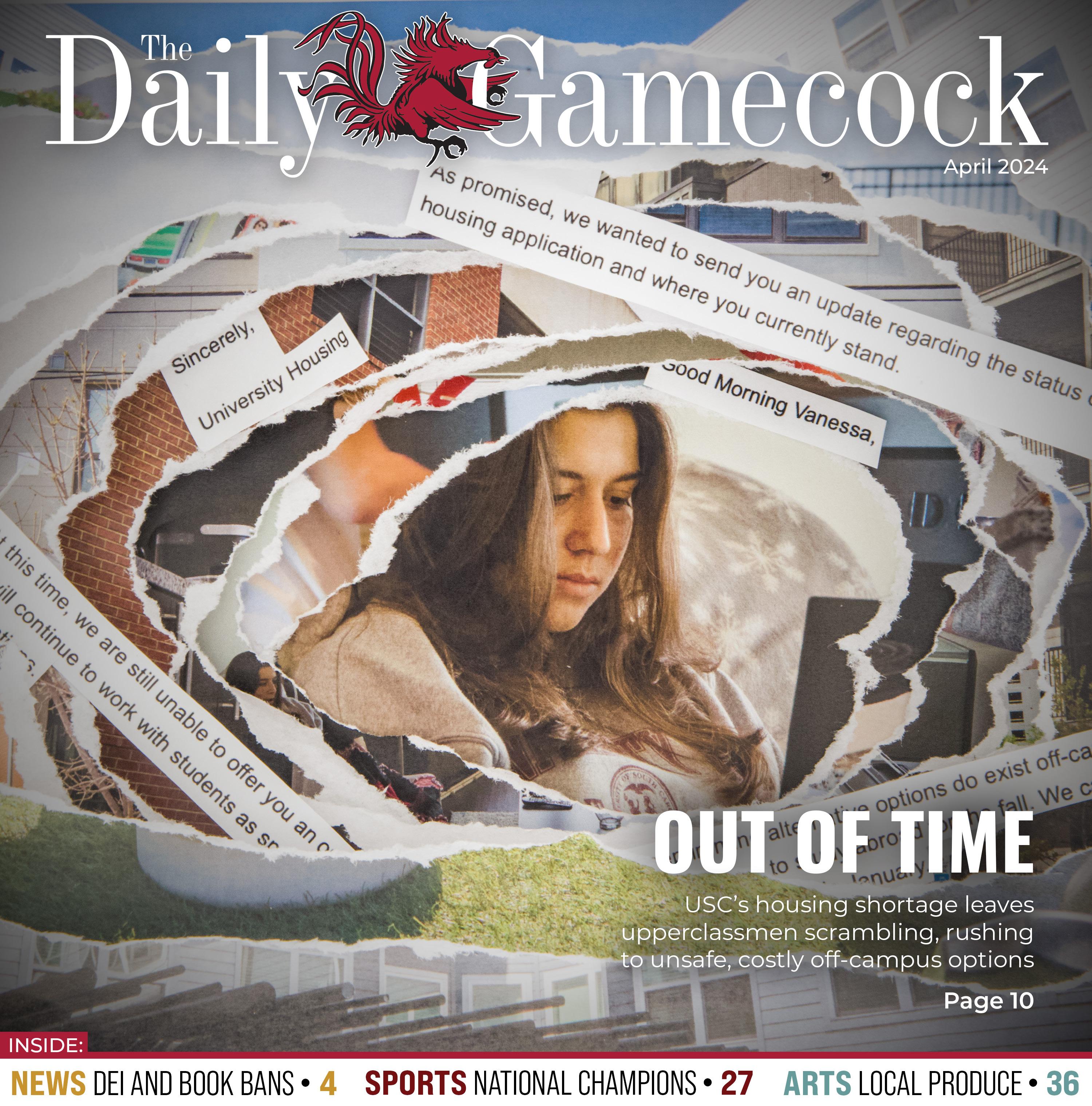

SEPTEMBER 19-21, 2024
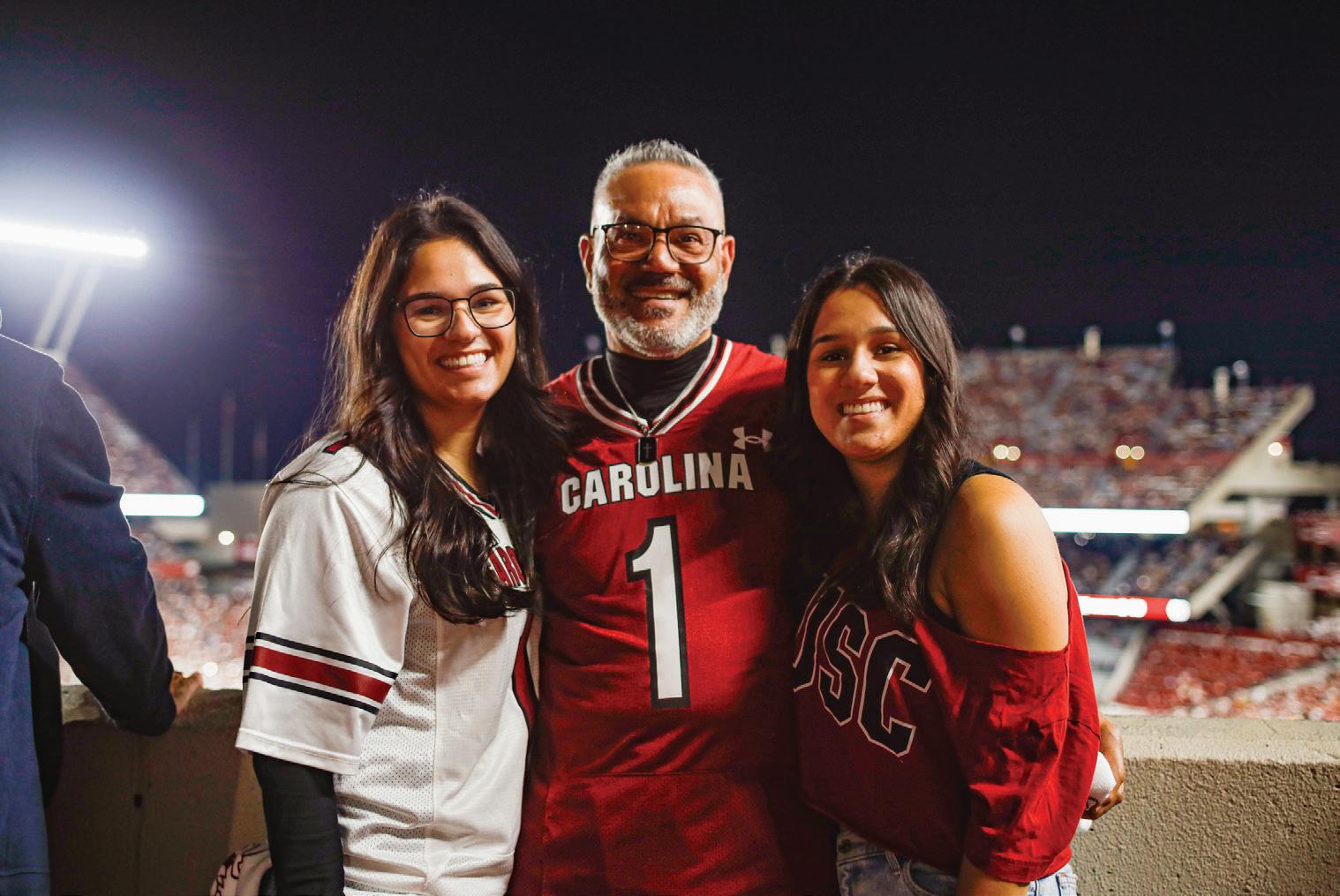

Family Weekend is open to all families as it is the perfect way to get to know the Carolina community better. While you're in town, spend time learning all our thriving hometown — Columbia, South Carolina — has to o er, visit our historic USC campus and meet fellow family members and students. Traditionally, this event includes educational sessions, receptions, and a spectacular football tailgate prior to watching the Gamecocks play!
Registration is required for the three signature events: President Meet and Greet, Rock the Roost, and Family Tailgate Party. Registration opens in July. For details, families can check out sc.edu/familyweekend


CONTACT US *Mobile app available on the App Store or Google Play Store 803-777-3008 scparents@sc.edu sc.edu/parents USC Parents APP

USC researchers use artificial intelligence to monitor brain waves that could help detect autism in infants.
The Sexual Assault and Violence Intervention & Prevention hotline may be added to the back of the card in fall 2024.
Members of the paper’s editorial staff write parting messages as they prepare to graduate in May.

Upperclassmen are running out of options for where they can live. What is the university prepared to do?
David Beasley joins the Joseph F. Rice School of Law to help bring global perspective. Former mall to be revitalized into a town center with retail.
South Carolina football looks to use experienced players from the transfer portal to help its running game in 2024.

How club sports go about obtaining money for their equipment, travel and practice needs.
The Gamecocks’ season comes to an end after its loss to Oregon in the first round of March Madness.
26 STUDENTS IN THE FOUNTAIN
USC students celebrate the national championship victory by making a splash.
South Carolina women’s basketball secures third NCAA National Title.
28 USC DANCE CLUB
Members of one of USC’s newest dance clubs share approach to allowing all kinds of dancers in.
29 THIS MONTH IN GAMECOCK SPORTS
Take a look back at notable moments in South Carolina sports history during April.
30 BASEBALL EXPECTATIONS
The Gamecocks defy early season predictions on both sides of the field.
32 FOOTBALL COACHING HIRES

South Carolina farmers share how Soda City has helped educate Columbia residents on healthy food.
35 LIVE AT THE UNDERGROUND
Head coach Shane Beamer welcomes two new members to his staff that are hoping to restore a winning mentality to the team. New music venue in the Russell House basement opens to local artists.
A Russell House expansion would benefit the entire student body.
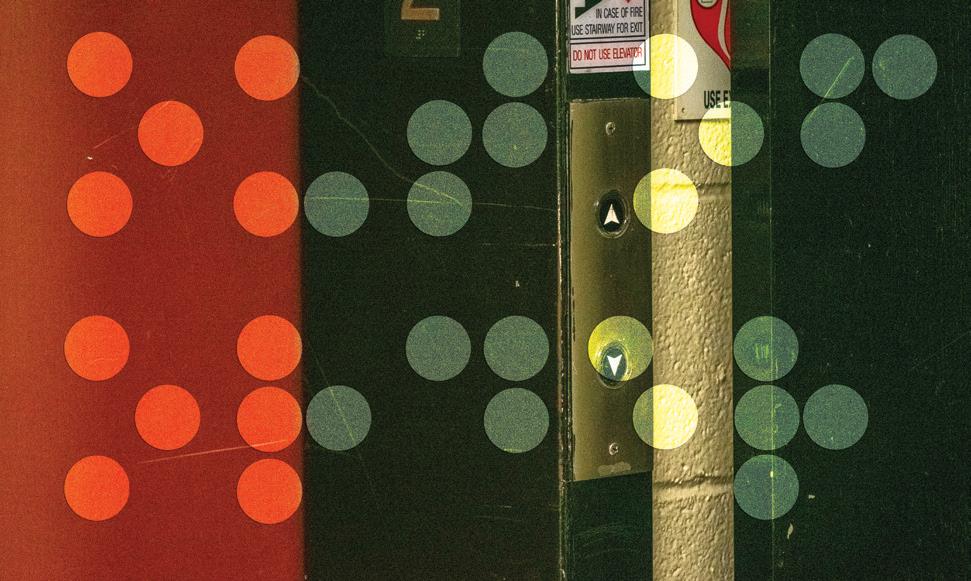
The university needs to make sure its facilities are accessible for people with disabilities.
A few members of The Daily Gamecock’s editorial staff detail their biggest journalism pet peeve.
Comic portrays each class’ reaction to making it through the academic year.
APRIL 2024 NEWS MAGAZINE COVER DESIGN BY: Clay Laucella COVER PHOTO BY: Daily Gamecock Visuals Team, Joshua Boucher with The State TABLE OF CONTENTS COVER CREDITS 03 FIRST-GENERATION COMMUNITY 04 DEI AND BOOK BANS 06 ARCHAEOLOGY CLASS 08 SAVIP AND CAROLINACARD 09 THE DAILY GAMECOCK’S SENIORS 10 USC’S HOUSING SHORTAGE 15 FORMER GOVERNOR JOINS LAW SCHOOL 17 RICHLAND MALL REDEVELOPMENT 18 AI AND AUTISM RESEARCH 21 RUNNING BACK ROOM 25 MEN’S BASKETBALL’S PARTING GAME 27 NATIONAL CHAMPIONS ... AGAIN 36 LOCAL PRODUCE 39 A STEP IN THE RIGHT DIRECTION 40 ACCOMODATION LAG 42 SPRING SEMESTER ENDING 42 GET TO KNOW US 22 CLUB SPORTS FUNDING USC to open new Living & Learning Community in Maxcy College.
Carolina sees ramped-up effort in the Statehouse to ban DEI iniatives and books in public schools.
Honors College class
for
that could help researchers better
the history of enslaved people.
South
USC
digs
artifacts
understand






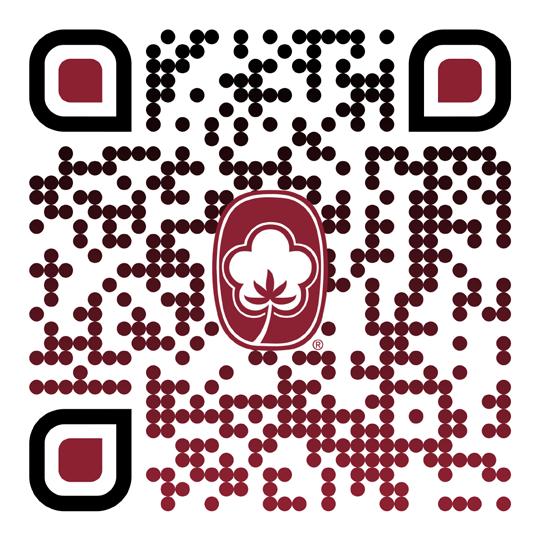










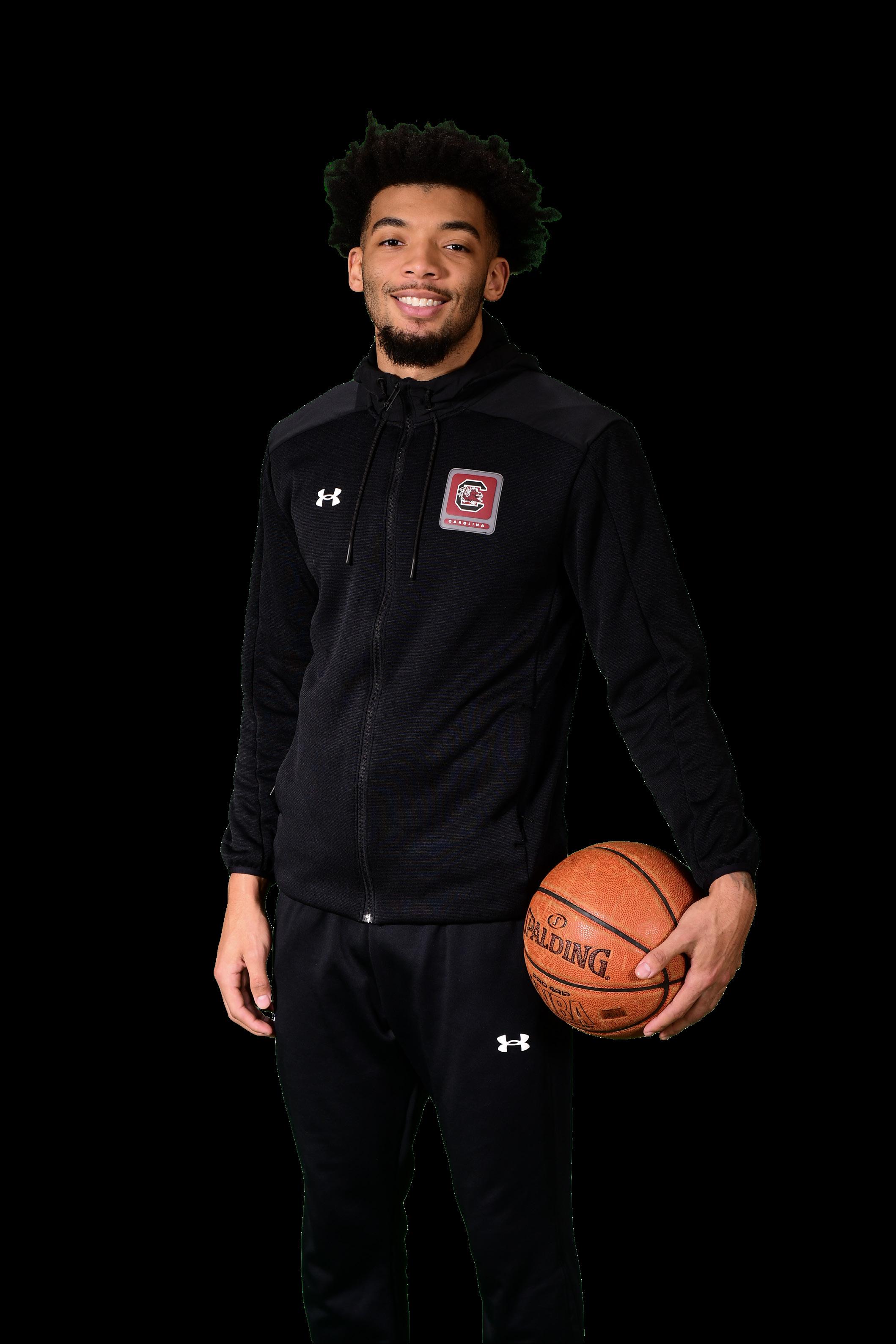
Visit an office near you or RelaxJoinFounders.com to see if you qualify for membership today! MAKE YOUR MOVE WITH THE RIGHT TEAMMATE!

First-generation Living & Learning Community to open in fall 2024
KAT SMITH| NEWS WRITER
USC’s Maxcy College residence hall is set to become a Living & Learning Community and resource center for first-generation college students this fall, helping to establish a support system for these students.
The center will be a resource in Maxcy for the 21% of students living on USC’s campus who identify as first-generation. The center, which will be available to all first-generation students regardless of whether they live in the residence hall, will provide services such as University 101 courses, advising and a student success center.
Maxcy will house roughly 100 incoming and 50 returning students in the fall. Applications are open for first-generation students who qualify for the community. Living & Learning Communities are residence halls for students with similar academic or personal interests that are advised by USC faculty and staff. The firstgeneration Living & Learning Community will be the 14th community added to the university.
Maxcy houses the Global Fellows community for students interested in
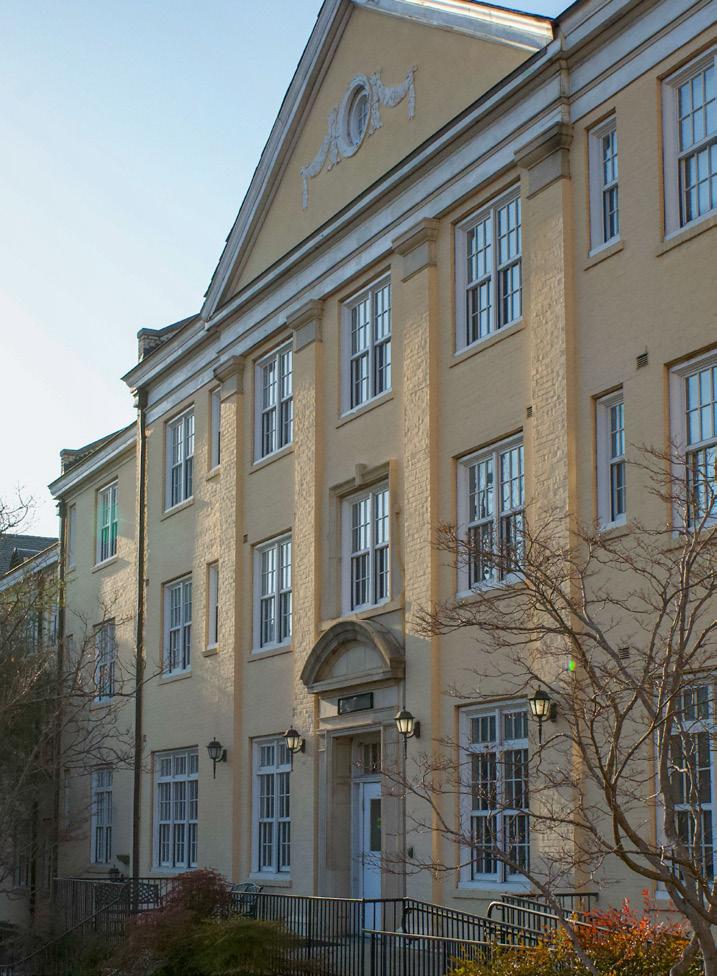
world cultures, which is relocating to South Quad Residence Hall in the summer.
Provost Donna Arnett, the executive vice president for academic affairs and a former first-generation college student, said she hopes the community will help ease the college transition process for USC’s first-generation students.
“We don’t want it to be a stigma of being first-gen,” Arnett said. “But you also don’t know what you don’t know when you’re a first-gen student because your family has never been through this process of coming into a big four-year college.”
One of the most crucial factors in a successful new community is having a faculty director to help form connections with students and build a community, Arnett said. The university is reviewing applications of candidates who hope to help lead the community in the position of faculty director.
Arnett said she hopes the firstgeneration Living & Learning community and center will not only help individual students, but also benefit the community socially and economically.
The community and resource center should provide students the confidence they need to assume leadership responsibilities, said Shelley Dempsey, the assistant provost for graduation and retention.
“When I’ve looked back at my own history and my career, I’ve looked at leaders, and then you think, ‘Oh, I think I might be able to do that or enjoy doing that,’” Dempsey said. “So we’re hoping and planning that some of that will take place and that we’ll be able to actually consider how many of the students stepped into leadership roles for future semesters.”
The university will research the success of the center using an insight survey. Dempsey said it’s important to note potential areas of improvement and apply them to the rest of the student population to make their transition into college easier as well.
“(First-generation students) have earned the opportunity to be a

Gamecock,” Dempsey said. “When they get here, we want to make sure that we are continuing to celebrate that with them and providing the supports they need.”
Anderson said she’s excited to launch the community’s mentoring program. Six to eight students who are majoring in the same subject may join a mentor group that is guided by a faculty member, a graduate student and possibly an alumnus.
“Whether that’s with peers, whether that’s with alum who are first-gen, whether that’s with faculty who are first-gen,” Anderson said. “We’ll have lots of opportunities for people who are passionate about first-gen or who are first-gen or have been first-gen
students themselves to participate in the community.”
The university is bringing in help from six committees made up of students, faculty and staff to brainstorm what else is needed in the community and resource center to make them successful.
“We just can’t wait to welcome students into the community and to support them in different ways through their interaction and engagement with each other, with faculty members and with the director of the new first-gen Living & Learning Community,” Anderson said.
A ribbon-cutting ceremony to celebrate the opening of the first-generation Living & Learning Community and resource center will take place on Aug. 22 at Maxcy College.
Maxcy College, pictured on Feb. 25, 2024, houses international students on the Horseshoe. The residence hall is set to transition from an international student hub to a first-generation Living & Learning Community in fall 2024.
Maxcy College sits on the Horseshoe, close to the center of campus, on Feb. 25, 2024. The residence hall will begin housing firstgeneration students in the fall.
PHOTOS: EMMA WYATT

Efforts ramp up across South Carolina to ban DEI programs, books in higher education, public K-12 schools
marley bassett | ASSISTANT NEWS EDITOR
The state of South Carolina has seen a simultaneous effort to ban diversity, equity and inclusion programs at higher education institutes as well as books at the K-12 level of education within the past year. can limit the availability of information about minority groups and their history, as well as place limits on what teachers can teach about history in both K-12 and higher education institutes, according to the Intercultural

Williams’ new title is “Vice President of Access, Civil Rights & Community Engagement.” His title was changed to spokesperson Jeff Stensland said in an
“His division will now align ongoing efforts to ensure access and opportunity to members of the campus community, compliance with federal civil rights and Title IX requirements, and foster partnerships with public and private sector entities to share university knowledge in support of local communities,”

and inclusive campus where marginalized students, faculty, and staff can achieve a sense of belonging, to an office strictly focused on compliance with nondiscrimination laws and policies,” Worthington said to The Chronicle.
University of Maryland College Park professor Roger Worthington said in an interview with The Chronicle of Higher Education that restricting DEI offices would limit student and university employees’ access to communities that would help
The South Carolina House of Representatives passed Bill H.4289 on March 27, which seeks to ban diversity training programs for public university faculty and staff, as well as prohibit diversity statements from being used in university admissions and employment decisions.
According to the bill, any higher education institute may not ask an applicant or employee to follow a statement in support or opposition of a political ideology, movement or issue, including diversity, equity and inclusion. Public higher education institutes are also prohibited from infringing on the right to free speech and may not discriminate in admissions or hiring based on a political viewpoint.
The bill states that public state colleges and universities must still abide by federal anti-discrimination laws, but it also says these institutions may not discriminate in admissions or hiring based on expression of approval or opposition to DEI and other political statements. If the bill is approved by the governor, it could eliminate mandatory DEI programs and
ILLUSTRATIONS: JON GLOVER
initiatives for faculty and staff at higher education institutes.
The bill would also require each DEI office at the public colleges and universities to compile an annual report detailing its costs, the number of people employed and any complaints the office received throughout the year.
The bill passed in the House on March 27 with a vote of 84-30.
The South Carolina House Republican Caucus released a statement celebrating the passage of the bill.
“This landmark legislation ensures no diversity pledges can dictate admissions or job outcomes, halts mandatory diversity training and upholds the unassailable right to free speech. It’s a bold affirmation of our commitment to equality and academic freedom, safeguarding our institutions against bias and promoting fairness in line with federal laws and standards,” the caucus said.
Rep. Mike Burns (R-District 17), a sponsor of the bill, said he supported the bill because he believes current DEI measures need to be changed, as they promote “strife and division.”
“We want everybody to be included. We want everybody to be treated the same,” Burns said. “But this has gotten way out of balance, and this (has) got to be brought back under some kind of control.”
The bill prompted opposition among some members of the House.
Rep. Jermaine Jackson (D-District 70), who spoke out against the proposed bill during a committee debate on March 26 according to WIS TV, said DEI measures help people understand the viewpoints and experiences that those in minority communities have.
Burns said the legislature previously took measures to ban DEI efforts, such as last year, when members of the House attempted to defund all of the public universities’ DEI programs, according to South Carolina Public Radio. Burns said those in support of the measure wanted all kids to be treated the same, and current DEI programs were promoting division.
“We tried to take the money out to stop the programs so kids could be treated the same,” Burns said. “So kids could be treated equally and treated with respect and not have all this division that we’re actually promoting under the guise of taking out racism when we’re actually causing it. So that’s why we
were trying to do this. And that’s why we’ll continue to do it.”
Rep. Kambrell Garvin (D-District 77), who spoke out against the bill in committee, according to SC Daily Gazette, said he wanted those listening to the debate who might lose increased access to college admissions and hiring to know they are still respected.
“For the kids that are listening, for the women that are listening, for the folks that belong to the LGBTQ community that are listening — you are valued, regardless of what this committee does or says,” Garvin said.
The Committee on Higher Education declined to comment.
The bill is in the Senate Committee on Education, but as of publication, a date as of April 7 has not yet been set for the bill to be debated both in committee and on the Senate floor.
Alongside efforts to ban DEI programs in higher education institutes, concurring challenges and bans on books available in public school libraries have also been occurring across the state.
Thirteen different school districts across South Carolina have faced challenges related to books in public school libraries that are considered by some to be “inappropriate” or “obscene” for school-aged children over the past three years, according to the American Civil Liberties Union.
Dorchester School District Two, one of two school districts within Dorchester County, saw in February one of the largest efforts to ban books in the state since 2020.
The complainant, Dorchester County resident Nancy Warner, belongs to a local group called Concerned Citizens for Education. She submitted a list of 673 books to the school board that she thinks should be banned. Warner said in an interview with Live 5 News that she found the list on the BookLooks and RatedBooks websites.
These sites are known for rating books on a zero-to-five scale that could have “inappropriate “ or “obscene” content for children. The higher the rating is, the worse the site claims the content in t he book is.
Some titles that could potentially get banned under this challenge include “Brave New World,” “Beloved,” “The Kite Runner,” “The Perks of Being a Wallflower” and “Slaughterhouse-Five.” The books, among others, have all been challenged for containing “obscene” and “inappropriate” content and themes related to
socialism, misogyny, racism and the LGBTQIA+ community.
Of the 673 book titles on the list, 155 were found to be in Dorchester School District Two’s school libraries.
Warner submitted the challenge to the school board, but under current board policy IJL, it was dismissed because she does not have a child in the school district.
The board, however, voted 4-3 to hear the challenge and send the list to the district’s media specialists to review. The vote occurred after board member Justin Farnsworth motioned to dismiss the challenge and send the ban request back to Warner.
The State Board of Education approved new regulations in February that would give the state control over the books that go in public school libraries rather than the local school board. All books challenged in school districts would then go before a committee made up of State Department of Education members for deliberation.
Vanessa Kitzie, an associate professor in USC’s School of Information Science, said the system being proposed would prevent professionals from being able to select what they believe to be appropriate materials for students.
She said the proposed system would instead rely on the ideological views of those in power.
“You’re setting up a system in which whoever is in power is then going to be able to decide what content is visible and what content is not visible based on their own ideological values, rather than having a trained professional who is operating using a set of professional values to make those decisions,” Kitzie said.
The regulations still have to be approved by the South Carolina Statehouse and governor before becoming law.
The proposed bans and challenges would limit the work that academics can do and undermine the work of librarians, Cooke said.
“This is what I mean by ‘lack of academic freedom’ ... Librarians are trained in collection, development and other things, and we know how to select books,” Cooke said. “We know how to provide readers (with) advice. We know how to recommend things to you.”
Kitzie said the bans could also restrict access to information about topics pertaining to members of the LGBTQIA+ community, which could, in turn, affect their mental health.
“It doesn’t reduce the amount of LGBTQ people who exist in the world,” Kitzie said. “Instead what it’s going to do is restrict their ability to understand the possibilities that are out there, which ... from a health perspective, can be extremely damaging.”
Everyone who opposes the potential bans on books and DEI programs should learn more information about the bans and their effects and then join together to stand up against them, Cooke said.
“I think there’s a lot of folks that don’t realize how serious this is and, unfortunately, might not find out until it’s too late,” Cooke said. “The more we have these conversations, I think the better organized we can be.”
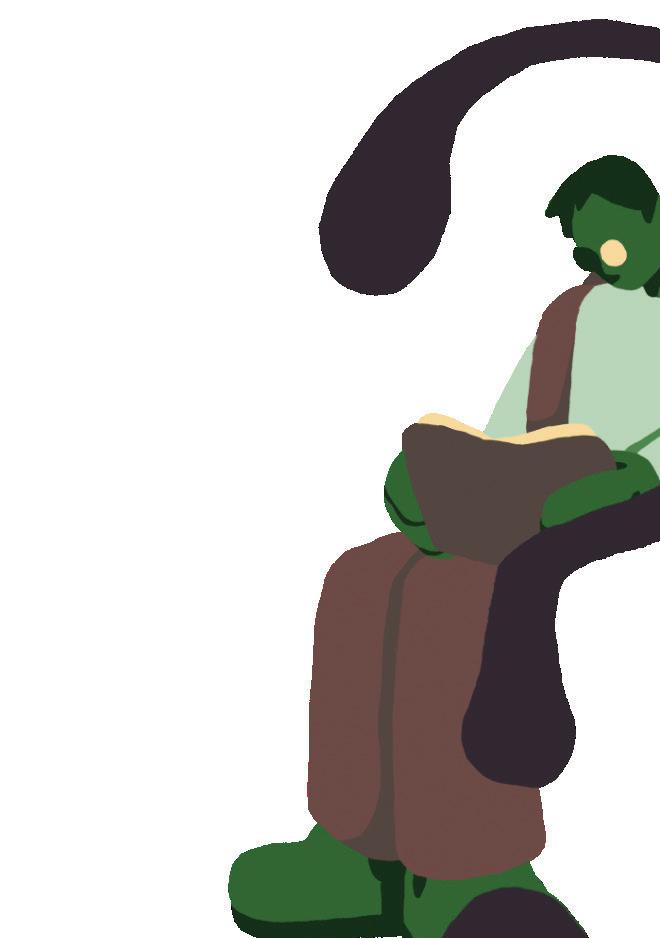
Honors College class digs for artifacts on Horseshoe, hopes to educate others on history of enslaved people
KAT SMITH | NEWS WRITER
AUSC Honors College class is digging on the Horseshoe for artifacts that could originate from campus before the Civil War. The project marks the first time in 51 years the university has granted permission for students to conduct excavations in the area.
The class, titled “Digging Through the Past: Exploring the Archeological Resources of USC,” is looking for items that could help tell the stories of enslaved individuals who once resided on campus.
Anthropology professor Katherine Goldberg, who teaches the class, said there is very little research about these individuals, and anything the class finds could help give insight into their lives.
The most notable objects the students have found so far are nails, ceramic pieces, glass, an unidentified metal object and a seashell, which have not yet been analyzed on how they could connect to the individuals that resided there.
“A lot of people think there’s (mystification), ‘Oh, you’re going to get really exciting, exotic artifacts,’” Goldberg said. “But we’re working in areas where we expect to find a lot of trash.”
Jill Found, a Ph.D. history candidate, is conducting a research project on the experiences of enslaved individuals at USC.
They spoke to Goldberg’s class about the lives of several enslaved people who resided on the Horseshoe when USC was known as South Carolina College prior to the Civil War.
Found said it is likely that most of the buildings on the original campus were built by enslaved workers. Some of the individuals were bought and owned by the university while others were personally owned by the professors. A number of tasks they would carry out included cleaning the dorms and classrooms, cooking and serving meals and taking care of scientific equipment in the chemistry lab, they said.
Some of the documents Found used to verify their research are recorded in university archives and personal records.
The class’ excavations could potentially help their research, Found said.
10 centimeters a student digs, another student records what objects have been found so far and the condition of the soil in that layer.
“One of the kind of mantras of archeology is, ‘You can only dig a site once,’” Goldberg said. “We are actively destroying data as we recover it because once we’re digging it up, we’re kind of changing the context.”
they’ve marked off the unit, a student gently removes the top layer of grass with a shovel to place it back when finished. The dirt is then shoveled into several different strainers the students use to sift for objects, which are placed into paper bags.
“I think that archeology is a really meaningful way to understand the lives of enslaved people because they’re often erased or left out of the historical documentary record,” Found said. “So, archival resources give us another way to learn about their lives.”
Goldberg said an extensive amount of research went into creating the map of the sites on the Horseshoe that the class would excavate, including the data from a ground penetrating radar, books on campus history and previous research on enslavement on campus.
Keeping meticulous documentation throughout the entire excavation process is extremely important, she said. For every
Twice a week, the students attend lectures on the groundwork they must do before excavating, such as using a ground penetrating radar to capture images beneath the earth’s surface and creating a map of the site.
The students wash each object by hand in the lab to better understand the finding and let them dry for a few weeks, Goldberg said. Then, they examine the objects for any identifying features or patterns.

Tina Sandoval, a second-year anthropology and environmental studies student, said she took the course due for its unique, hands-on approach to learning.
Her favorite aspect of the class so far has been Found’s lecture on the history of enslaved individuals on campus, she said.
“Being from Columbia and having Black family, I always knew that enslaved people were a part of the establishment of the university,” Sandoval said. “But I never knew that the university actually did own someone who was enslaved, and enslaved people really do have a more vibrant history or a more notable history with the university than they are given credit for.”
The excavation days are challenging because even though the labs are long, it is usually not nearly enough time to finish the process, she said. The students have also faced weather challenges, such as having to dig while it’s raining or in freezing temperatures.
But Sandoval said being friends with her classmates makes the experience easier.
“The good thing is the culture of the class is just so fun and supportive — that we’ve really powered through it,” Sandoval said.
Some of the artifacts the students have excavated are on display in McKissick Museum. The class will continue to add to it as more are found throughout the semester.
Once a week, the students head out to the Horseshoe for a three-and-a-halfhour lab, digging and sifting for objects in the sites that they have mapped out.
The students first use geometry to measure the site where they should dig by looking at the map. Once
“We’re hoping that our work will help make that something we can bring more attention to,” Goldberg said. “Again, not in a negative way, but to acknowledge that the stories of the people who were enslaved on campus, of their descendants, are real and deserve attention too.”
Second-year accounting and finance student Samantha Addeo analyzes items found underground on the Horseshoe on Feb. 14, 2024. Select artifacts the students excavate will be on display in McKissick Museum.
PHOTO: DELANY KRAL

Future USC CarolinaCards to include SAVIP hotline
CARRIGAN WOODSON | STUDENT GOVERNMENT BEAT WRITER
USC students, faculty and staff could see a change to their CarolinaCards in the fall 2024 semester with the addition of the Sexual Assault and Violence Intervention & Prevention hotline to the back of all future cards.
The SAVIP hotline is available 24/7, and it connects members of the USC community with confidential interpersonal violence advocates. The hotline also provides support for various scenarios, including academic assistance as well as housing and workplace accommodations, said Ashley Quirk, the associate director of SAVIP.
“Our advocates provide support — really empowerment-based support — to primary and secondary survivors of interpersonal violence,” Quirk said. “Here, we define interpersonal violence as any form of violence. Some of the key areas are sexual assault, domestic, dating, relationship violence, any kind of stalking and harassment.”
Quirk said putting the hotline on the back of CarolinaCards is just an extra measure to ensure that the number is easily accessible to people.
Aidan Gruner, a first-year exercise science student and student senator, said the prototypes for the new CarolinaCards were developed over spring break, and the next step is to physically print them out. The goal is to have the new prototypes finalized so they will be available for the incoming freshman class to receive cards with the hotline.
to join senate, which was because I was hearing a lot of different cases regarding sexual assault (and) harassment, and I wanted to make a difference for that,” Gruner said. “After a couple of my friends had circumstances where a few of them were assaulted or mistreated, that was, you could say, the nail in the coffin that led me to want to do everything I could

to advocate and help make change and to hopefully bring a resource that could help so many others.”
various campus offices, such as SAVIP and CarolinaCard, to ensure his legislation is enacted.
“Senator Gruner came to me kind of with this initiative and really a passion for making sure that folks in the Carolina community knew about ... the important topics that we serve (and) what our resource means for students and being
they want to talk about it, but the problem is they don’t know who to (report it to),” Gruner said. “SAVIP is here to help bridge that gap, but a lot of students aren’t often aware of who to talk to, and even if they do, what can that resource provide to them.”
When Gruner went to the CarolinaCard office to discuss adding the hotline, he was met with support by members of the staff.
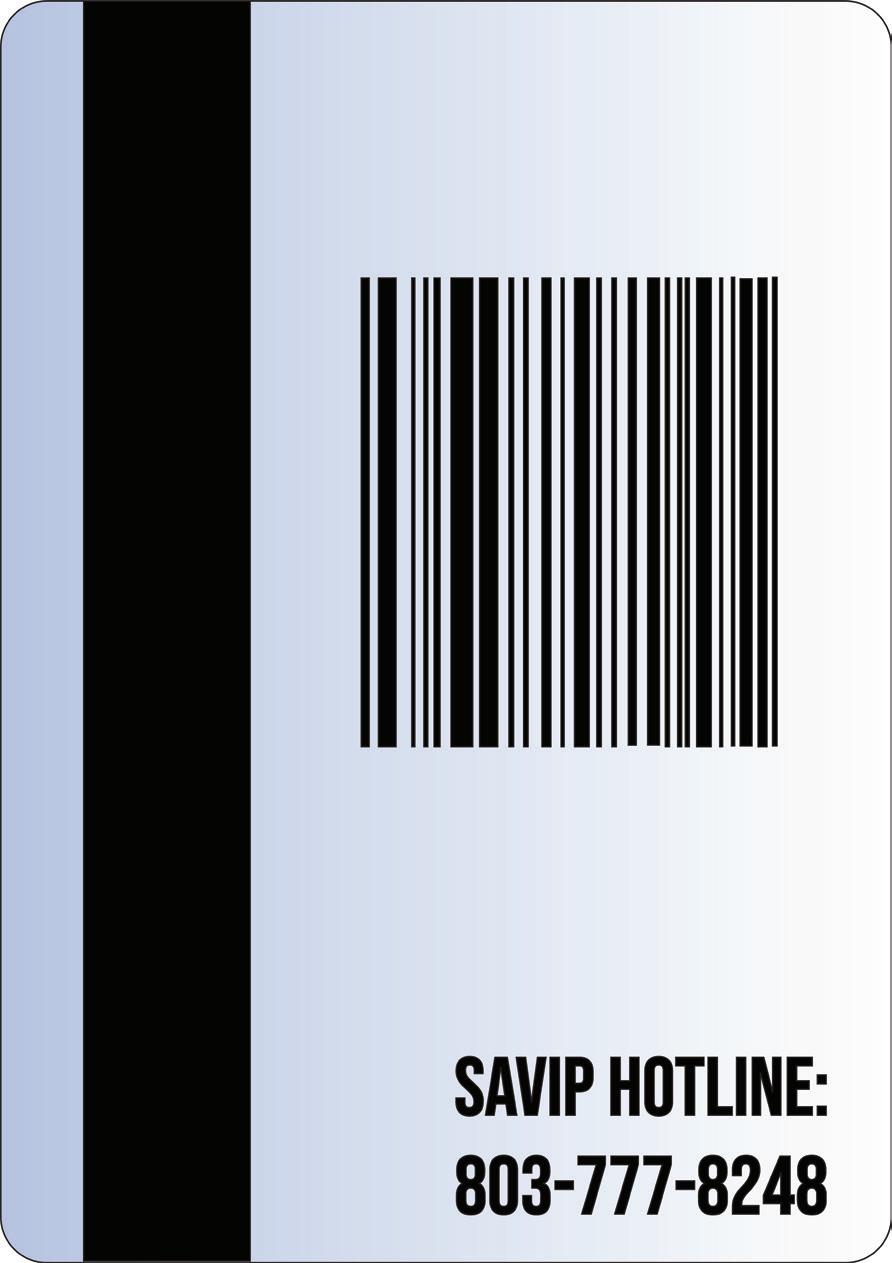
able to have that directly on campus,” Quirk said.
For students and staff who already have CarolinaCards, they will not have to get a new one unless their current card is lost or needs to be replaced, Gruner said.
Gruner wrote the bill that proposed the addition of the hotline to the back of CarolinaCards. He said the bill holds a personal significance for him, which inspired him to advocate for it.
“The inspiration behind the bill actually dates back to the same reason I chose
Gruner said he sought a resource that could effectively address students’ needs, such as advocacy, legal assistance and counseling, and he found that SAVIP encompassed all of these aspects. He observed that there’s still a lack of awareness among many students — mainly underclassmen — regarding the organization and now aims to increase awareness about the organization and the resources it can provide to students.
Since Gruner’s bill was passed at the end of February, he has been able to visit
Quirk and Gruner said the abundance of information students receive about available resources on campus can be overwhelming. When students are in a crisis moment, they might not know who to reach out and talk to, Quirk said. So putting the hotline on the back of CarolinaCards allows students to have an easily accessible resource at the tips of their fingers.
“It’s important to have this number accessible because a lot of both research and personal stories that I’ve heard from students has been that a lot of people have situations, and they want to report it, and
“When (Gruner) came to me early on in the semester, and we’ve had a couple of meetings to talk about this, I was immediately supportive just because, again, any time that the CarolinaCard can be used as a resource to provide information to students and others, I think it’s a good thing,” said Joseph Fortune, the director of business affairs.
Adding new features to the CarolinaCard does not happen often, Fortune said. Typically, requests such as Gruner’s undergo an initial review by the Division of Student Affairs and Academic Support before proceeding to the CarolinaCard office. The decision to implement changes depends on multiple factors, such as available space on the card and community impact potential, he said.
Despite the various steps required to add new features to CarolinaCards, Fortune said adding the hotline to the card was the right thing to do for the student body.
“The CarolinaCard (is) kind of a passport for everything. I think part of it is that it also serves as a resource,” Fortune said. “Having SAVIP and other information on the back of the card is just — we think that is a great resource location for students. So everything from the SAVIP piece to the national suicide lifeline text piece on the back and hotline on the back, it’s an easily accessible place for resources.”
Illustration: GRANT RICHA
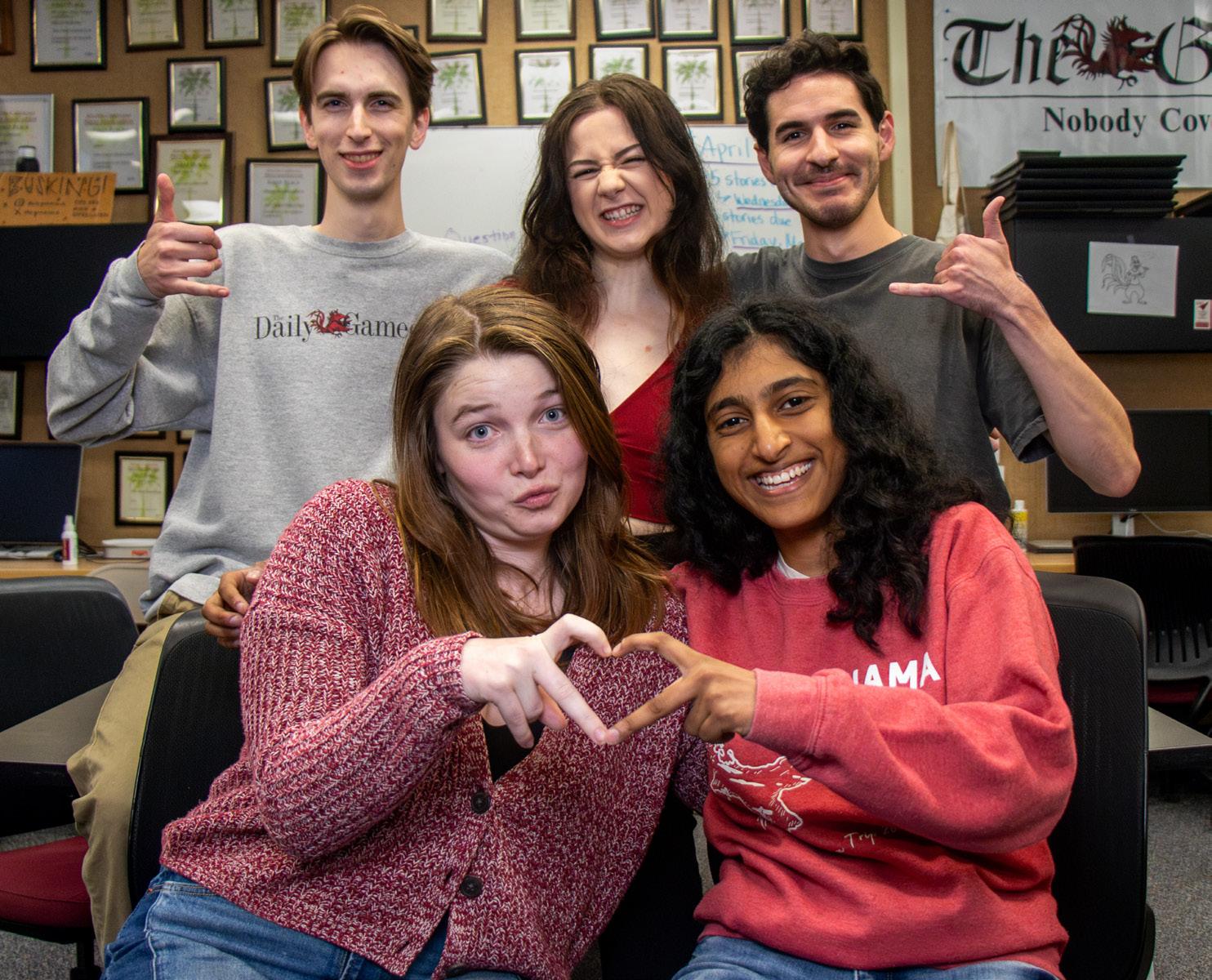
Senior sentiments
The end of spring semester always means the loss of a few of The Daily Gamecock’s beloved senior staff members. Here are a final few words from our graduating seniors.
RILEY EDENBECK - MANAGING EDITOR
“One of the most important things I’ve learned during my time at USC is that you have time! I found my community after three changes to my major and nearly four years at USC. I’m so grateful to this team for their guidance and friendship. Forever to TDG, and forever to thee!”
ANNA OTTINGER - DESIGN DIRECTOR
“I’m so glad to have found such a great community and in many ways a home in The Daily Gamecock. Live, laugh, I never learned AP Style!”
varsha gowda - opinion editor
“Peace out.”
Clay laucella - senior designer
“It’s a bittersweet moment for me to graduate and leave TDG behind. I joined on a whim after transferring to USC my junior year to get involved on campus, and I’m so glad I did. I’m grateful for all the experience I’ve gained, great memories I’ve made and amazing people I’ve met along the way. We’ll be seeing ya.”
WILL KELLY - ASSISTANT SPORTS EDITOR
“Thanks for giving me a social life. I’m going to miss the hive mind. GO SPORTS!”



Today !
Book Your Appointment
PHOTO: ALICIA CARACCIOLO
From left to right, starting in the top row, sits Will Kelly, Riley Edenbeck, Clay Laucella, Anna Ottinger and Varsha Gowda in The Daily Gamecock’s newsroom. All five are graduating seniors, and their time with The Daily Gamecock is coming to an end after the spring 2024 semester.

Out of time: USC’s housing shortage leaves upperclassmen scrambling, rushing to unsafe, costly off-campus options
KATE ROBINS | EDITOR-IN-CHIEF ALEXA JURADO & MORGAN HUGHES | REPORTERS WITH THE STATE NEWSPAPER
This article was reported and written in collaboration between The Daily Gamecock andThe State newspaper.
Vanessa Alaimo sits in her freshman dorm, stress building by the moment as she types desperately on her laptop.
She’s just received a rejection email from the University of South Carolina’s housing department — they won’t have a bed for her next year — and she’s growing frantic, not knowing where she’ll live come fall and quickly trying to figure out her options. It’s only February, but already her choices are limited.
She’s combing through apartment websites, but many off-campus student apartments have already sold out of leases. The ones closest to campus, such as Greene Crossing, The Hub and The Station, have just a few spots left.
The more Alaimo searches, the more she worries. Questions like “How will I afford monthly rent?” and “Will my financial aid help?” start flooding her mind.
She’s running out of time to find her next home. And she’s not the only one struggling.
Each year, thousands of students at South Carolina’s flagship university scramble to find places to live in the heart of the capital, often forced to make difficult — and quick — choices between high-priced, newly built private apartments downtown or cheaper but sometimes poorly maintained housing farther from classes and campus life. All the while, USC doesn’t come close to providing enough beds for its 28,429 undergraduates and, in recent years, has done little to make up for the shortage of housing available for its ever-growing student body.
Despite growing its student body by more than 9,000 over the past 15 years, USC’s on-campus housing stock has only increased by some 2,840 beds in roughly the same time. Just over a third of USC students are able to live on campus, meaning the
majority of the rest are pushed into the greater Columbia area combing for rentals.
The discrepancy between students and beds has generated a wave of private student apartment construction in recent years, with many developments taking advantage of generous public tax incentives that have been offered specifically to address the severe need for beds for USC students.
Rents at downtown student apartments range from around $800 to more than $1,600 per room per month. They’re marketed with luxury amenities ranging from swimming pools to gyms to study rooms that all come with a price and are often known to fall into disrepair.
Several of them are also known to be hotspots for theft and security breaches — all happening beyond the gaze of university officials, who offer limited housing support for students living off-campus.
Is USC doing enough to manage the housing needs of its students, or is its hands-off approach fostering an untenable renting environment?
The university finished building its new Campus Village dormitory complex in August, just in time for its largest freshman cohort ever. The class of 2027, which exceeded 7,000 students for the first time, was hundreds more than initially expected.
Campus Village, which includes four residence halls, a dining hall and retail spaces, was nearly a decade in the making and the largest construction project in USC’s history. The massive development on Sumter and Whaley streets is home to approximately 1,800 students.
It was supposed to alleviate housing problems. Or at least some of them.
But the $240 million state-of-the-art facility was a mere fix for the university’s recent shortfall, after some students had to be put up in hotels a year prior. And today, the university isn’t poised to get ahead of future growth.
‘How am I going to afford to stay here?’
Freshmen already begin to flock to offcampus apartment complexes in September and October — only weeks after starting their first college classes — hoping to secure a place to live nearly a full year in the future. The longer they wait, the less likely they are to find an affordable and safe apartment.
This past fall, Alaimo toured 21 Oaks apartments near Williams-Brice Stadium, the Lofts on south Main Street and the Hub downtown, but none met her expectations. She wanted the employees to be honest with her, she said. They instead met her with “lavish amenities,” which brought in additional fees.
A tour that started out advertising a two-bedroom apartment for $750 quickly became more than $1,000 per month for add-ons such as parking and a porch, she said.
Sure, there were cheaper options. But those were farther away from campus and didn’t have glowing reviews from other students, Alaimo found.
“It was kind of crazy to me that they expect college students to afford $1,200 a month just to be in a safe, nice location,” Alaimo said.
Moving off campus wasn’t Alaimo’s first choice. And the same goes for many USC students looking beyond their freshman years.
USC requires freshmen to live on campus their first year and has 17 residence halls to accommodate the population. About 7,344 freshmen were housed on campus for 2023-24.
But students who want to continue living on campus in their sophomore years
have relatively few options. Eight campus buildings are available to upperclassmen, but seven of those choices are reserved for just Honors College students, Capstone Scholars and students who are a part of Living & Learning Communities.
Any other freshman who wants to live on campus their sophomore year has only one option: the 649-bed Park Place apartments, which were originally built in 2016 at the corner of Blossom and Huger streets as private off-campus apartments but were absorbed by the university in 2017, in part to help meet demands for on-campus housing. Park Place contains mainly upperclassmen, but the university does not reserve the beds just for them.
More than 2,400 current students have applied to live on campus as upperclassmen in the fall, according to university spokesperson Collyn Taylor. The university is unsure how many will be granted housing.
In Alaimo’s case, she applied in October of her freshman year to become



a resident assistant — a paid university housing position that would also guarantee on-campus housing — and, come January, applied separately for on-campus housing as a backup. In February, she was rejected from both.
But in the meantime, many private offcampus apartment rooms had already been snatched up — still more than half a year before the next academic year began.
“My first thought was, ‘How am I going to afford to stay here (at USC)?’” Alaimo said. “I felt like it was a lot of wasted time because to go through all that whole process, I mean, it’s very disappointing.”
Downtown development boom
In 2014, as the student population in Columbia continued to climb, city leaders saw an opening.
“We knew there would be a significant need for more student housing,” said Steve Benjamin, Columbia’s mayor at the time. But the move was also strategic, he added, to increase the number of private entities paying taxes — a limited opportunity in a government town.
So to boost the tax rolls and to help the university meet the growing demand

for student housing, the city along with Richland County in 2014 granted developers of student housing projects a 50% tax break for 10 years in exchange for investments of at least $40 million.
In a matter of years, downtown was flush with student housing, with thousands of new residents spread across incentivized projects, such as the 724-bed Greene Crossing apartments in the Vista, the sixstory, 650-bed Empire apartments on Assembly Street and the 660-bed Station at Five Points development slightly farther away from campus.
Plus, other projects not included in the incentives program, such as the 847-bed Hub, also came online. The first citycounty tax incentive program for student housing only lasted a few years, but the private apartment
wave — and tax breaks for new projects — have continued.
Today, a 940-bed apartment project, Gadsden + Greene, is being developed by the university’s development foundation near Colonial Life Arena, and a 700bed private development named Verve Columbia is in the planning stages for the intersection of Blossom, Huger and

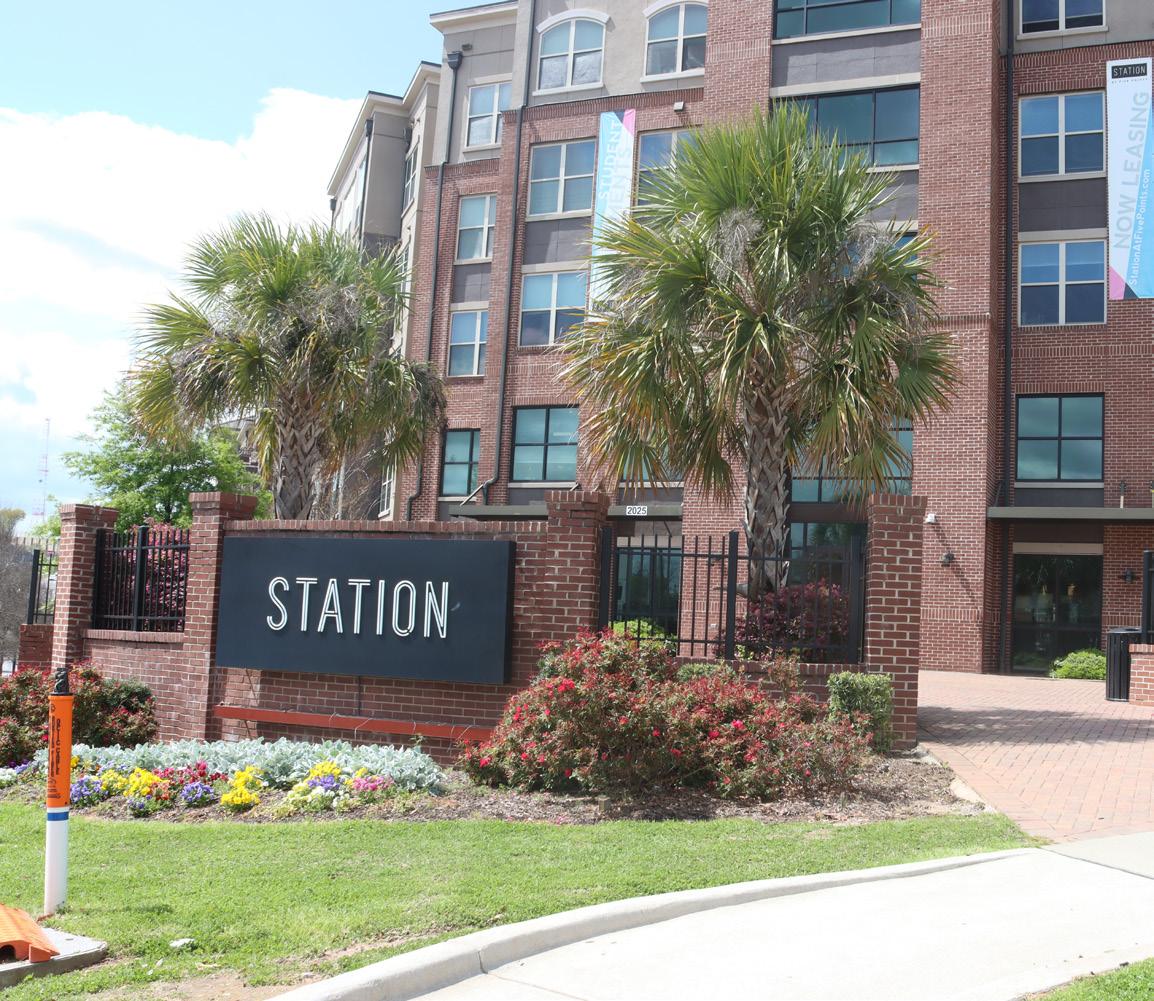
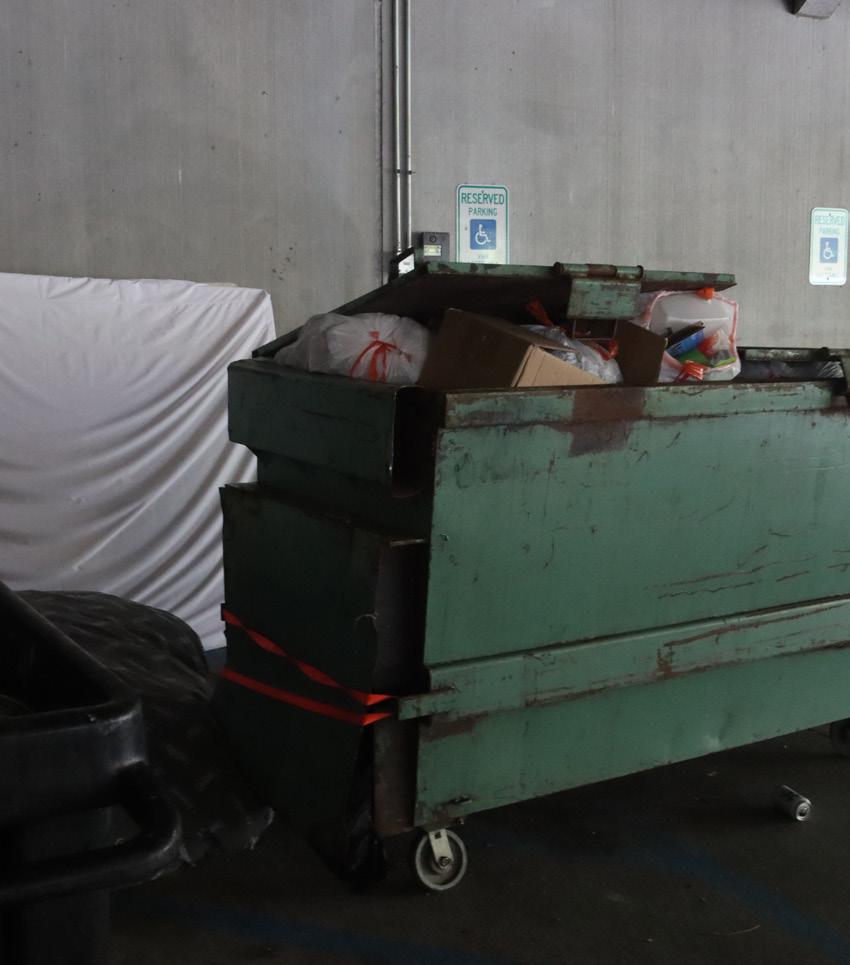
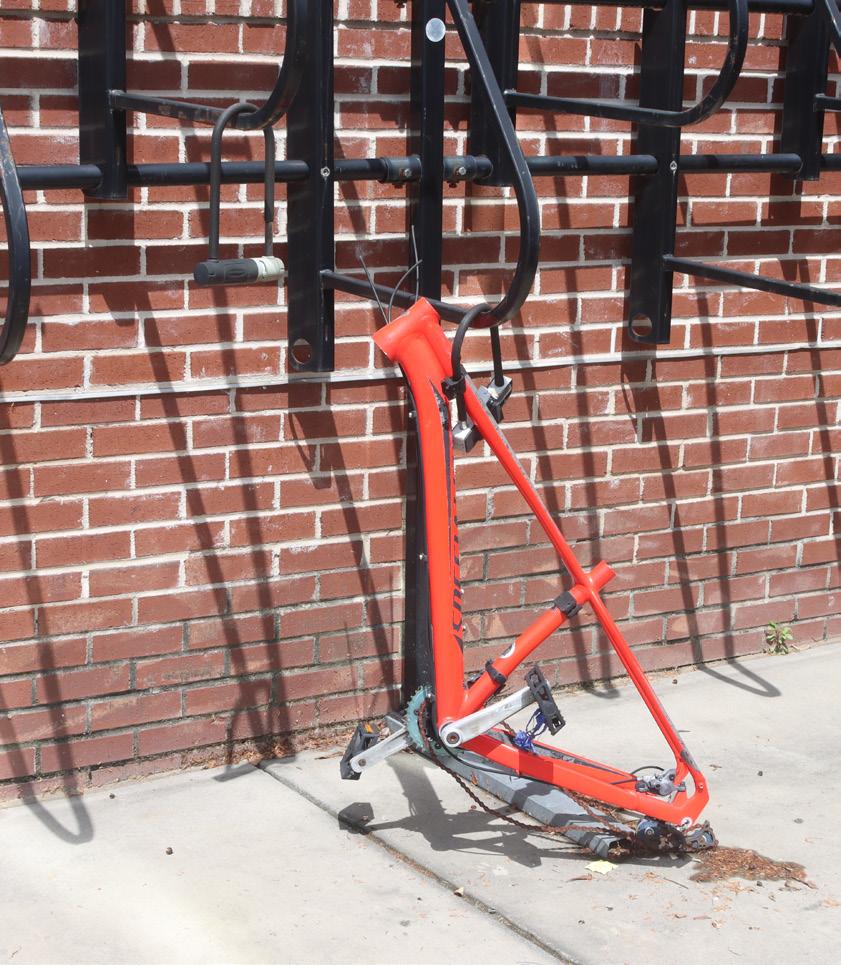


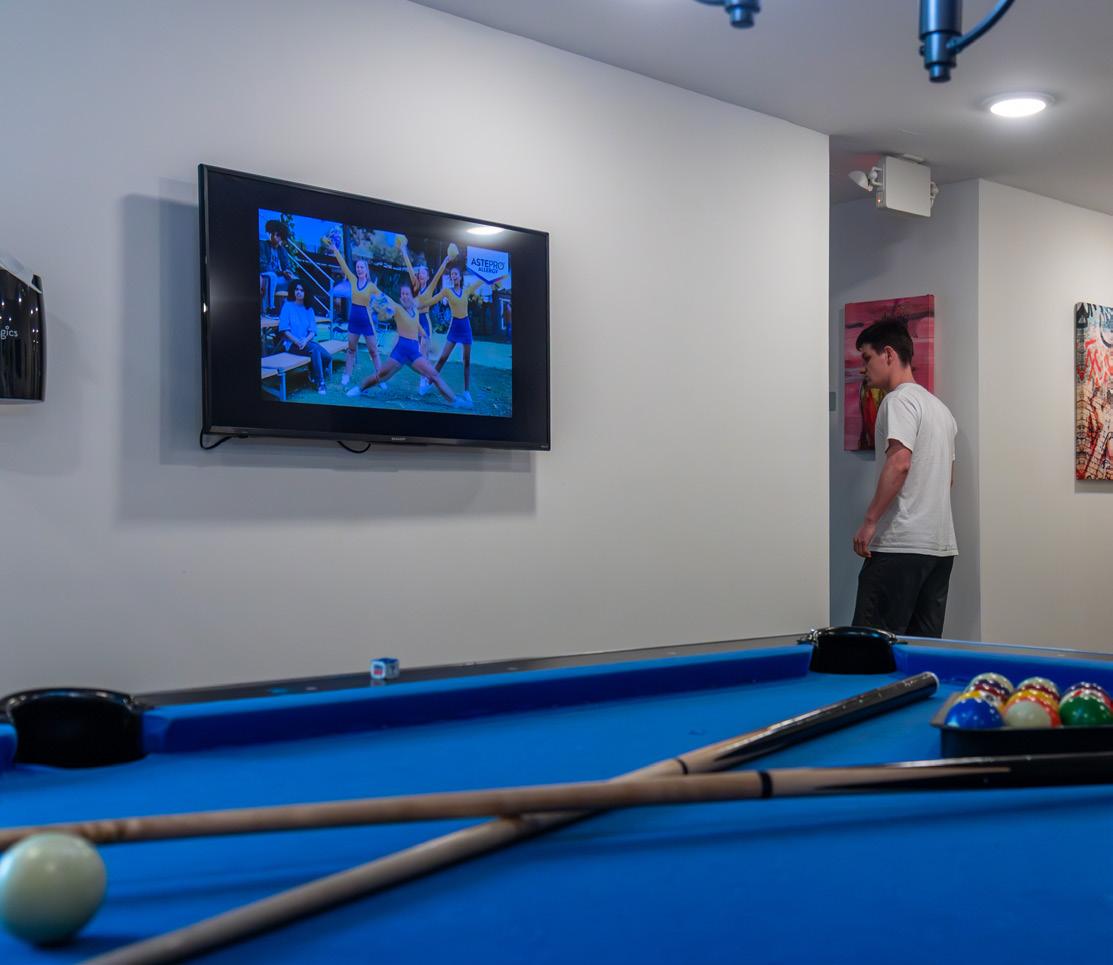
Wheat streets near the USC baseball stadium.
The newer downtown apartments offer nicer amenities than their older counterparts, but they also come with higher rents. And, despite those rents, residents and their parents say they don’t
Photos of different parts of the Station’s exterior capture areas where students have reported crimes to Columbia Police Department. Incident reports obtained by The State and The Daily Gamecock show that students reported crimes related to theft or auto theft the most.
Photos of the exterior and interior of Empire show the complex’s signage and amenities. The student apartment is one of several in Columbia that students race to sign a lease with in October and November.
PHOTOS: DELANY KRAL
PHOTOS: XAVIER MARTIN
always feel like they’re getting what they pay for.
Students have complained about faulty air-conditioning, insufficient WiFi and a lack of communication from management companies, which have been known to change frequently through the years.
At The Station, for example, residents said they dealt with trash in the hallways after the floor’s trash chute would pile up. And at Greene Crossing, students said it would take anywhere from two weeks to over a month to fix utilities.
“(Management was) very, very rude when you asked or confronted them about any issues,” said Rae Jones, a Greene Crossing resident and third-year computer science student. “It’s not unreasonable to expect to have the things that you pay for in your home.”
we learn to interact with a large, younger population.”
Another issue student apartments have is keeping non-residents out, Waggoner said.
“It is a challenge for them to keep the doors secure,” though not for a lack of trying, Waggoner said, adding that a personalized key fob won’t be effective when there’s a rock propping open

And incident reports from the Columbia Police Department show safety and security also have been issues at certain downtown properties.
Twice at the end of 2021 — once in November and once the day before Christmas — residents at The Station at Five Points were robbed at gunpoint.
At Greene Crossing, one person in late 2021 reported being violently assaulted while waiting for a friend at the property’s parking lot. An unknown person got in their car, beat him and robbed him at gunpoint, according to an incident report from the department.
The majority of the incident reports obtained by The State and The Daily Gamecock were not for violent crimes, but auto break-ins and other thefts were common. Columbia Police Captain Cynthia Waggoner agreed that auto break-ins are the top crime problem at student apartments.
“It’s exciting to see the growth,” Waggoner said of the influx of student apartments downtown. “(But) it has created some challenges … as
At Greene Crossing on Pulaski Street, 31 incident reports were taken by police between January 2021 and November 2023. Roughly 40% of those incidents involved an auto break-in or some other incident involving the apartment’s parking garage.
In one 2022 incident, two people entered the parking garage at the apartment complex and stole a golf cart in addition to tools and HVAC parts.
USC does not endorse or promote any student apartment, said Derenzo Thomas, the assistant director for community engagement in the Leadership and Service Center. Instead, he tells students and parents to do research on the apartment and use the Community Crime Map to help make a decision about where is best to live.
Student Body President Patton Byars said during his campaign that he hopes to address insufficient on-campus housing options and inadequate information provided to students regarding off-campus housing.
“We see the first-year banners (that say) the ‘No. 1 first-year experience,’ and that’s great and we don’t deny that, but there’s a reason we don’t have the best four-year experience, and we don’t have a banner for it,” Byars said. “It’s because we don’t have it.”
Thomas has worked as the assistant director of Community Engagement for three months. He helps students evaluate their housing options while explaining terminology they’re not familiar with.
He sits them down, discusses their requirements for where they want to live and points them to a few options or to Garnet Living, a website where complexes or property managers can partner with Garnet Media Group to list available housing options for students.

Greene Crossing’s property manager, Amanda Williams, said that, since ownership changed at the apartments in 2022, management has added a handful of new security features, including fobs for entry into the parking garage.
Two Columbia police officers also live at Greene Crossing, serving as “courtesy officers” who do nightly patrols of the property and report directly to Williams, she said.
Waggoner said most student apartments downtown do have courtesy officers like Greene Crossing. She also said any apartment complex can request that a courtesy officer live at their property, not just downtown student apartments.
And when students come forward with safety concerns, Thomas and Director of the Leadership and Service Center Amber Hiott talk with the property managers to see how the apartment’s management will address the issues.
Students want more support.
Thomas sits in his office inside Russell House, USC’s student union, where he takes on one of his primary responsibilities: helping students find off-campus housing. This one university staff member is the main campus resource for students who need help with off-campus housing.
Students have said they don’t feel they have enough support or options from the university when it comes to finding housing.
As of this spring, he’s spoken to around 60 students about finding somewhere to live off of campus, he said.
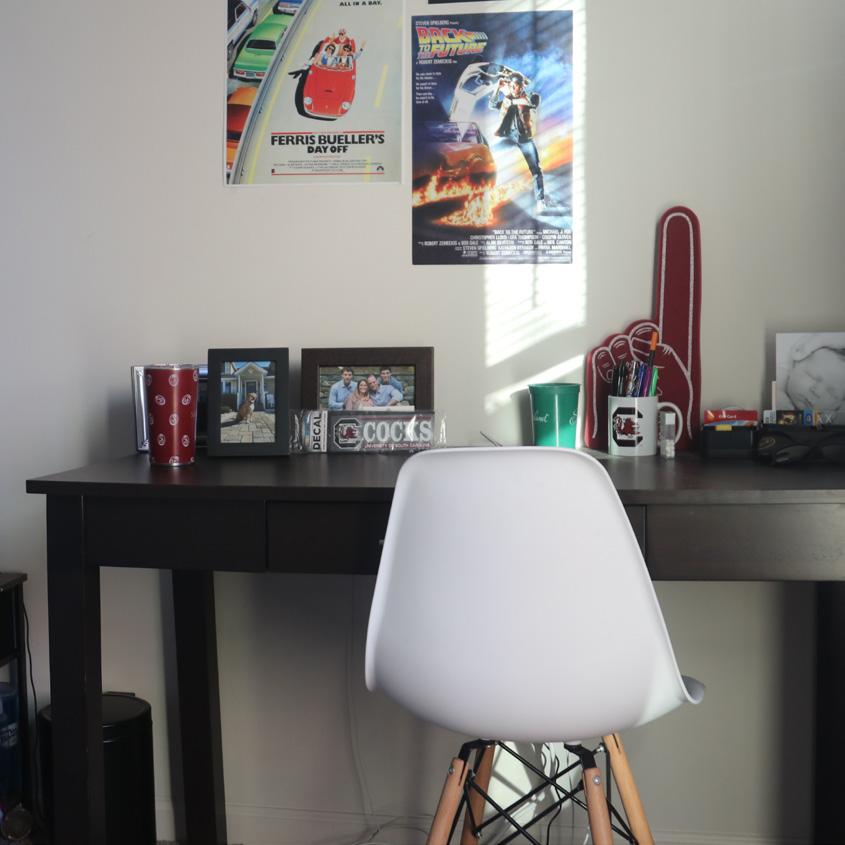
Several students have walked away with a better understanding, he said. It’s just a matter of helping them find somewhere to start and listening to them, Thomas said.
Alaimo said she wishes there was more support from the university for upperclassman students. She and other students, she said, have been frustrated with a lack of options for oncampus housing.
Thomas and Hiott have been working to make students more aware of the resources the center offers, they said.
The administration knows there are limited spaces for on-campus housing, Thomas said. And they have an “action plan” in place to make that fact more clear in the future and to prepare students to look at leases. They are hoping to get students more involved in apartment searching before the on-campus housing deadline by visiting residence halls and having open conversations with students in the fall, Thomas said.
What’s not clear, though, is whether university officials have a sufficient action plan — or cash flow — to house their growing student body.
Will USC’s plans meet students’ needs?
At a January retreat, the university’s board of trustees explored possibilities for its
But it does have consequences. As the university grows, so, too, does the desire to live on its grounds.
On-campus housing, at one time, was strictly for freshmen, said USC spokesperson Jeff Stensland. Now, more and more upperclassmen are looking to stay in university accommodations for longer.
“I believe many of the continuing students have such a great firstyear experience that they often want to stay,” Tolliver said. “That is not something you see in large numbers across the country.”
Tolliver, who has previously worked at other large public institutions, said in that sense, USC is unique. After their first year, Tolliver said, some USC students feel “distant” living off-campus, far from the amenities and experiences afforded to them as a freshman.
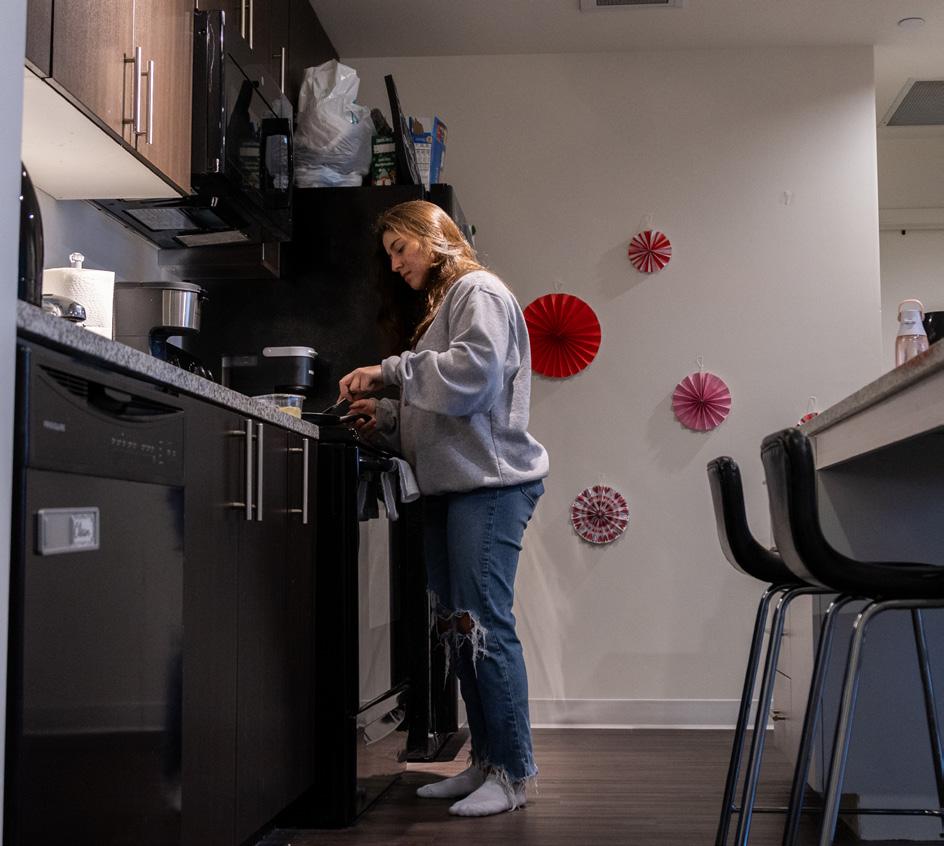
As a first-generation college student who lived on campus through his senior year, Tolliver said he recognizes the importance of having an environment where a student can tap into institutional resources. Convenience is one factor. Student success is another.
“It’s a big campus, but through on-campus experiences we

Master Plan. It was an ambitious look at what campus could look like, from a new student union to a sprawling engineering district.
At that retreat, university architect Derek Gruner estimated a need for an additional 2,500 beds in the near future and more Greek Village housing for fraternity and sorority members.
the potential to raise bed count by about 500. A third wing of the Honors College residence hall would also be built, with an additional bed count of 140.
Those additions, though, would only make a dent in the 2,500 beds Gruner estimated the university needs soon. Even still, some 20,000 USC students would still be forced to live off of campus.
“We try to accommodate as many upperclassmen as possible who want to live on campus,” USC said in a statement. ”But, like most universities, we currently lack enough on-campus housing to meet the demand of every upperclassman who would prefer living on campus.”
The university said there are “many” resources that help students transition to off-campus life and says it’s “trying to enhance” housing options.
The 2024 USC Master Plan update also identified Bates West, Bates House, South Tower, Capstone and Columbia Hall as sites to renovate and redevelop.
City leaders think more private student housing is imminent.
Columbia City Councilman
Peter Brown, who helms the city’s economic development committee, said he sees a lot more student apartments, and housing of all kinds, in Columbia’s downtown future, and he supports giving more incentives to help meet the need from USC’s continued growth.

The burgeoning student body is a good problem to have, said Rex Tolliver, USC’s vice president for student affairs.
Unlike other institutions of higher education, many of which are or will soon be suffering from a perceived demographic shift and dropping enrollment, interest in public flagship schools — like USC — abounds.
can create community,” Tolliver said. “Knowing that … we have to continue to then invest in more housing and new housing to meet the demands of students.”
While nothing is set in stone, USC’s board of trustees approved a request for an initial design phase to replace the McBryde dormitory, a badly aged residence hall with 260 beds. The McBryde buildings would be demolished, and new ones would be erected on the site, with
“We’re going to grow anyway, and we’ve traditionally (grown) rather randomly,” Brown said, adding that the city’s involvement and the use of incentives also helps the city have slightly more say in the growth.
Tolliver was adamant that USC retains the ability to house all of its freshman students, even with a projected increase in enrollment. It is upperclassmen who may feel the pressure of growing pains. But Tolliver wants to fix that, too.
“I want to get the university in a position that we can house anybody, any student who wants to be housed on campus, whether you’re in your first year or your fourth year,” Tolliver said. “It’s just going to take some time for us to do that, so we can do it strategically.”
Editor’s note: Emmy Ribero, Win Hammond, Marley Bassett, Riley Edenbeck and Sydney Dunlap of The Daily Gamecock contributed reporting.
Student apartment Greene Crossing sits at the corner of Pulaski and Greene streets. Residents of Greene Crossing told The Daily Gamecock and The State that they have had to deal with faulty Wi-Fi, broken appliances and a lack of communication from management.
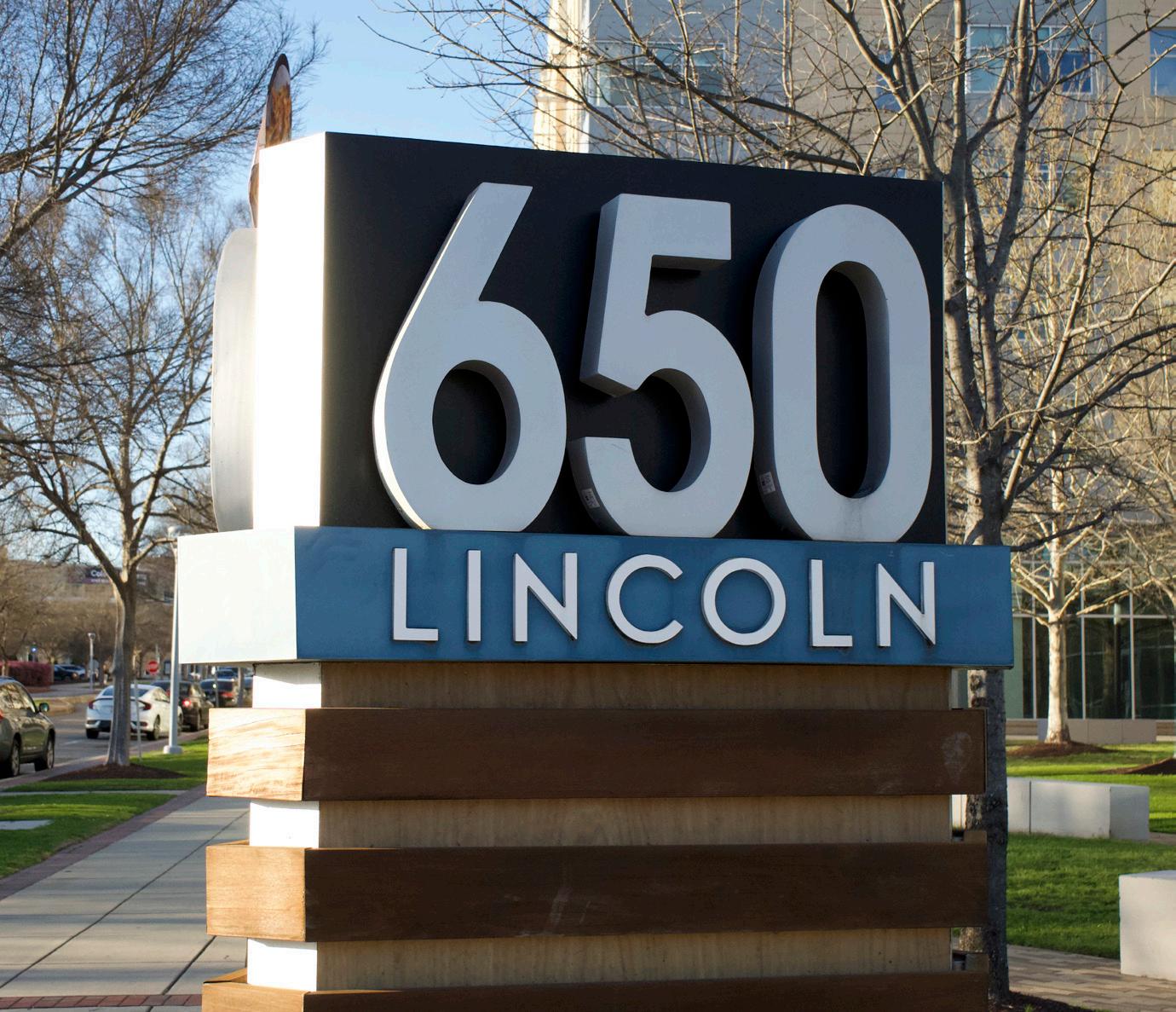 Photos of the interior of Vanessa Alaimo’s apartment and the exterior signage of 650 Lincoln show the apartment’s features. 650 Lincoln is home to Honors College students, Living and Learning Community students and student athletes.
PHOTOS: JOSHUA BOUCHER & NICKOLAS HILL
PHOTOS: ALICIA CARACCIOLo & EMMA WYATT
Photos of the interior of Vanessa Alaimo’s apartment and the exterior signage of 650 Lincoln show the apartment’s features. 650 Lincoln is home to Honors College students, Living and Learning Community students and student athletes.
PHOTOS: JOSHUA BOUCHER & NICKOLAS HILL
PHOTOS: ALICIA CARACCIOLo & EMMA WYATT




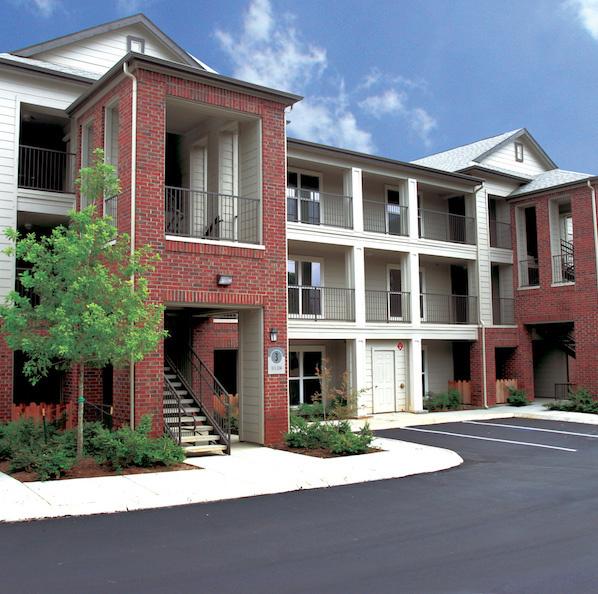



500 Alexander Road | West Columbia, SC 29169 | 803-939-9209 CollegeTownOnTheRiver.com | @CollegeTownOnTheRiver 2, 3, & 4 BEDROOM APARTMENTS Come see why the WeCo side of the river is the best place to live! Gated Community Resort Style Pool Fully Furnished In-Unit Washer & Dryer Shuttle to Campus Pet Friendly Fitness Center
Former South Carolina Gov. David Beasley joins law school faculty, aims to provide global perspective on leadership
EMMA DAVISSON | INFRASTRUCTURE BEAT WRITER
Former South Carolina Gov. David Beasley has returned to USC.
Beasley — once the youngest Speaker pro tempore in the nation, the governor of South Carolina and the director of the United Nations’ World Food Programme — said he has always tried to lead with compassion and unite others.
Now, Beasley is serving as a professor in the Department of Legal Studies for the Joseph F. Rice School of Law. Beasley officially joined the law school’s faculty on March 1.
Originally from Lamar, South Carolina, Beasley was studying
microbiology at Clemson University when he decided to run for the House of Representatives. The choice catapulted his career in politics, which has spanned over two decades.
“I had this idealistic mindset,“ Beasley said. “Going into the House of Representatives, to me, was like, ‘How can I help the most people and build a better system that will live beyond me?’” Being in the House created conflicts with Beasley’s college schedule, so he transferred from Clemson to USC his senior year.
Beasley graduated with a degree in interdisciplinary studies from USC and
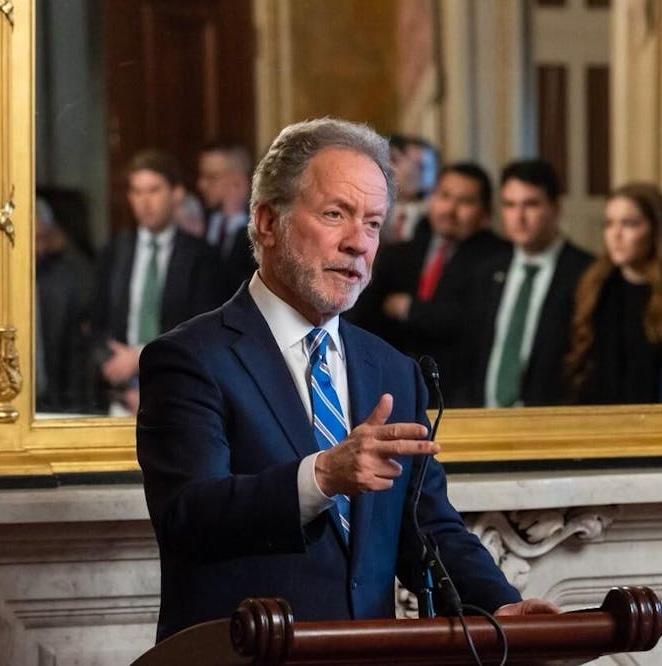
finished law school in 1983. He served as governor from 1995 to 1999, where he was credited with improving the state’s economy and challenging the use of the Confederate flag.
Though it cost him reelection, Beasley was awarded the John F. Kennedy Profile in Courage Award in 2003 for advocating for the flag’s removal from the top of the Statehouse.
“There was no political advantage at all for me to touch that issue until after the election,” Beasley said. “But you know, you’ve got to do what’s right when you know it’s right to do it.”
Though his courses as a professor have not yet been finalized, Beasley has already started guest lecturing at the law school, the Honors College and the College of Arts and Sciences.
Beasley said there are several lessons he hopes to impart on law school students.
“Number one: A small-town person can achieve extraordinary things,” Beasley said. “I can assure you that I was no better or smarter than the average person. It’s just hard work. Number two: Don’t let people get in the way. There’s always negative people. Ignore them.”
Law school Dean William Hubbard said he hopes Beasley will serve as a role model for law students.
“I think he will help open their eyes and minds to the threats and the geopolitical situation around the world,” Hubbard said. “Secondly, he’ll be a role model for our students. Here’s a young man from Darlington (County), South Carolina, who did great things on a global stage. And the message to our students is you can (do great things) too.”
Beasley served as director of the World Food program for six years before stepping down in 2023. The program, organized by the United Nations, has a mission of providing food to save lives and avoid mass migration due to food insecurity. Under Beasley’s direction, the program fed more than 80 million people worldwide and raised $14.2 billion in his last year as director.
Beasley accepted a Nobel Peace Prize on behalf of the World Food Programme in 2020.
Hubbard said Beasley brings a unique international perspective to the law school. Beasley’s experiences will expand students’ perspectives and provide them with a broader worldview, he said.
“Because he was on the ground in so many places ... he got a lot of on-theground information about the world order and problems in the world today,” Hubbard said. “And I think his ability to share some of that with our students is an incredible opportunity for growth.”
Kjursten Collier, the president of the International Law Society, attended a presentation by Beasley at the law school in 2023.
“(Beasley) was very informative and focused on his work with the UN World Food Programme,” Collier said in an email. “I certainly think he’s a great addition to the school, and I’m certainly disappointed that I will graduate before he begins teaching.”
Second-year pre-law student London Patel said she thinks Beasley will benefit the law school.
“I think him coming here will spark sort of a chain reaction of getting other higher-ups faculty-wise,” Patel said. “I think it’s definitely not to be taken as a con. It can only help South Carolina.”
Beasley said his biggest mission is to improve the leadership of today’s generation.
“I think that’s going to be one of the great hopes I have is to impress upon this next generation of leadership,” Beasley said. “Stand strong for what you believe in, and do it in a respectful way.”
Hubbard said Beasley is a “doer” with a determination to address problems.
“His greatest strength is his deep compassion and commitment to his fellow human beings,” Hubbard said. “He is set out to make a big difference.”
Former South Carolina Gov. David Beasley speaks to a group of people at the South Carolina Statehouse in Columbia, South Carolina. Beasley joined USC’s Joseph F. Rice School of Law on March 1 as a faculty professor in the Department of Legal Studies.
COURTESY OF DAVID BEASLEY

SCMUSEUM.ORG | 301 GERVAIS STREET BE CURIOUS Explore Art, History, Science & More Visit Today Unknown maker. Face Vessel. c. 1855-1865. Alkaline glazed stoneware. Collection of the South Carolina State Museum.
Richland Mall redevelopment aims to reinvigorate Columbia area
Richland Mall, a shopping mall off Forest Drive, is set to begin its redevelopment into a lifestyle center promoting upscale retail and community engagement.
Located at the entrance of Forest Acres, the redevelopment will feature a grocery store, retail spaces and apartments in the style of a town center. Forest Acres also plans to build a park with an amphitheater next to the new development.
The redevelopment represents a shift from the traditional mall format to an open-air atmosphere. Consumers today are more focused on the ease and community of their shopping experience, said Mike Watson, the undergraduate director of USC’s department of retail.
The goal of reinstating a sense of community and interconnectivity since the COVID-19 pandemic has influenced some of these changes, he said.
“People’s desire just to interact more has really been the drive for these lifestyle (malls),” Watson said. “From a business perspective, it also makes sense because
it’s more cost-effective to build this type of structure than it is these massive squarefootage malls.”
Richland Mall officially closed down in 2023. The interior of the mall has been closed to the public since 2022, but stores such as Belk and Barnes & Noble retained exterior storefronts for a while.
Belk closed in September 2023, and Barnes & Noble relocated to Garners Ferry Road in March 2024, which completed the closure of the mall, according to the Carolina News and Reporter.
Cost was one of the challenges involved in attracting a developer for Richland Mall, Watson said.
The mall, which encompasses 32 acres, was an expensive plot of land to buy. The 930,000-square-foot “concrete dinosaur” would also be costly to demolish, said Lynnsey Baker, a public information officer for Forest Acres.
Southeastern, a commercial real estate agency based out of Augusta, Georgia, purchased the property in January 2023 for $18.6 million. The deal would not have
been successful without the tax incentives offered by both the city and county, said Jason Long, the senior vice president of Southeastern.
The city and state developed a plan to allow Southeastern to “borrow against (its) future tax value,” Long said. This would give the company $23 million to assist with building improvements and demolition costs.
Forest Acres also bought a portion of the original plot to turn into a public park. The 6 acres will be separate from Southeastern’s property, but it will still be valuable to the redevelopment project, Long said.
“It’s a great benefit to our project. Just brings a lot of people to the property and supports the retail,” Long said. “It’s a great amenity for the residents, but it’s a great amenity for the whole community.”
The parking lot of the mall, which is included in the land bought by Forest Acres, will be turned into the city’s largest green space using $3 million from South Carolina’s state budget.
“It’s not often we get a chance to buy 6 full acres and build a park,” Baker said. “It was a once-in-a-generation opportunity for the city to acquire that much land.”
There is not an anticipated price for the mall or park redevelopment as of March 2024. The project is expected to be worth $100 million by the end of phase one, which will include the addition of retail spaces, apartments and a grocery store.
Phase two will likely include more retail and apartments, Baker said, but no plans have been presented for it yet.
Third-year retailing student Olivia Andrew said she thinks Columbia residents will benefit from the greater variety of stores to shop from.
“There’s definitely a lack of shopping in Columbia,” Andrew said. “It’s a necessity thing, but it’s also just — I feel because there are so many young people in Columbia, it would be nice to have more options for people to shop, and even if they’re just doing it for entertainment purposes.”

NEWS 1 7
Emma Davisson | infrastructure beat writer
Courtesy of Lynsey Baker
for
in Forest Acres shows an open-air shopping center instead of a traditional mall format. Richland Mall officially closed in 2023, but the mall’s
to the
since
A rendering of the redevelopment plans
Richland Mall
interior has been closed
public
2022.
Researchers at USC use AI, brain waves to detect autism in infants
Olivia Helfen | News Writer
Ateam of researchers at the University of South Carolina is working with AI to research autism spectrum disorder and ways to diagnose it at earlier ages.
Researchers on the team are a part of the Carolina Autism and Neurodevelopment Research Center on campus. According to its website, researchers at the center work to improve the lives of families and individuals with neurodevelopment disorders by advancing research and education around autism. Jessica Bradshaw, a professor of psychology at USC, leads a team of researchers examining how brain waves and heart rates could show signs of autism in the first few months of a child’s life.
Typically, children who have autism spectrum disorder are not diagnosed until they are 2 or older because behavioral signs have to show, Bradshaw said. As a result, there is not much data about autism in children younger than 2, she said.
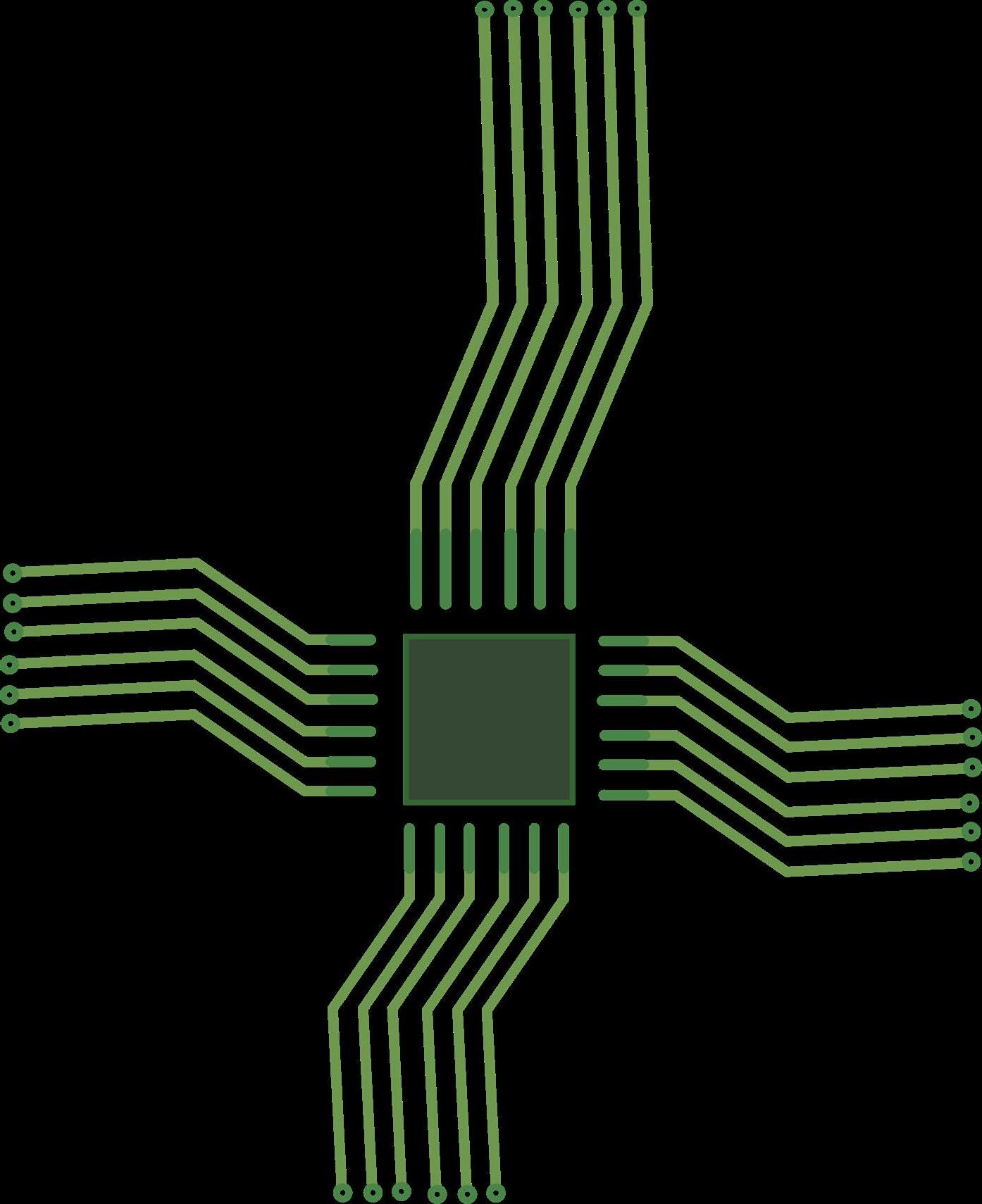
“There’s no specific biomarkers, no blood tests, no single gene that causes autism, so we really can’t diagnose until those behavioral features are more prominent,” Bradshaw said.
Caitlin Hudac, a professor of psychology, assists Bradshaw in collecting data by observing children with autism. They assess observable traits such as behavioral or cognitive responses during their testing.
The data collection is a large part of the research. But the team uses AI as an assistive tool to help understand the data collected, said Christian O’Reilly, an associate professor of computer science and engineering at USC. O’Reilly is the third member of the team and oversees the AI aspects of its research.
O’Reilly said AI helps the team visualize relationships between the behavioral, environmental and genetic variables they observe in their testing. AI compares data sets and recognizes patterns between them,
allowing the team to test assumptions they make while researching, he said.
“(The data) says how much of that assumption is true,” O’Reilly said. “So, it’s a completely different framework to phrase the problem and to investigate the problem.”
In their research, AI is used to understand complex relationships in the data, but there are many assumptions about it, O’Reilly said. Most people understand AI, or machine learning, in a science-fiction sense, but in actuality, it is simply an algorithm made to assist a person in completing a goal, he said.
Hudac said the researchers all have a different expertise or focus, and they don’t always have a shared understanding of all the topics involved. They work together to apply for grants and analyze the data on heart rates and brain waves collected, so it was essential for them to find shared terms or principles that they can all understand, she said.
“There’s a lot of equations that go into computer science and AI development,” Hudac said. “And that’s a challenging piece — to make sure that we’re able to talk about things in the same words and understand kind of the basic principles.”
O’Reilly said another issue in their research is that autism is a spectrum, meaning that everyone who has autism spectrum disorder presents it differently.
“All the classical approaches assume that that is a homogeneous group of people, and they are not,” O’Reilly said.
As a result, O’Reilly said the team is working to group individuals together based on how they present to better understand the data they collect and help that group specifically.
So far in their research, they have been able to better understand and model how heart rates may indicate autism in infants with the help of AI, drawing clear relationships from test results, Bradshaw said.


“What we call AI and machine learning are very set algorithms,” O’Reilly said. “If you see the AI algorithm as a black box, so, you have two sets of variables ... and there’s a complex relationship between the two, and you just want to use that box to learn that relationship. That’s the only thing that this algorithm does.”
There are a few challenges the team is continually working to overcome, such as finding a shared language between researchers and the complexity of autism spectrum disorder research, Hudac said.
could have higher results, while others may have lower results. The drastic differences make the average test results the same as a neurotypical group, which poses more challenges in collecting and assessing data, he said.
Bradshaw said she hopes to continue the research and apply for other grants that will allow them to collect data in homes, making it easier for families to participate in their studies. Most data is collected in their lab, but she said they hope to be able to get more portable equipment that would allow them to go to more homes. Conducting studies in home environments makes the process easier on families and expands the team’s test group, she said.
“We’ve done a lot of work to identify different systems and processes for collecting data in the home that’s just as rigorous as the data that we collect in the lab,” Bradshaw said. “I think that there’s still some improvements we can make with our in-home data collection, but that’s
AI is an important new avenue that could help to accelerate the understanding of autism spectrum disorder, Hudac said. It is essential that researchers understand how AI can impact the field of research and help kids in the long run,
“We inherently live in a social world, so figuring out a way that makes sense for them to live in the social world and be happy and satisfied is really important to the work we do in my lab,” Hudac said.
NEWS 18
illustration: Anna Ottinger
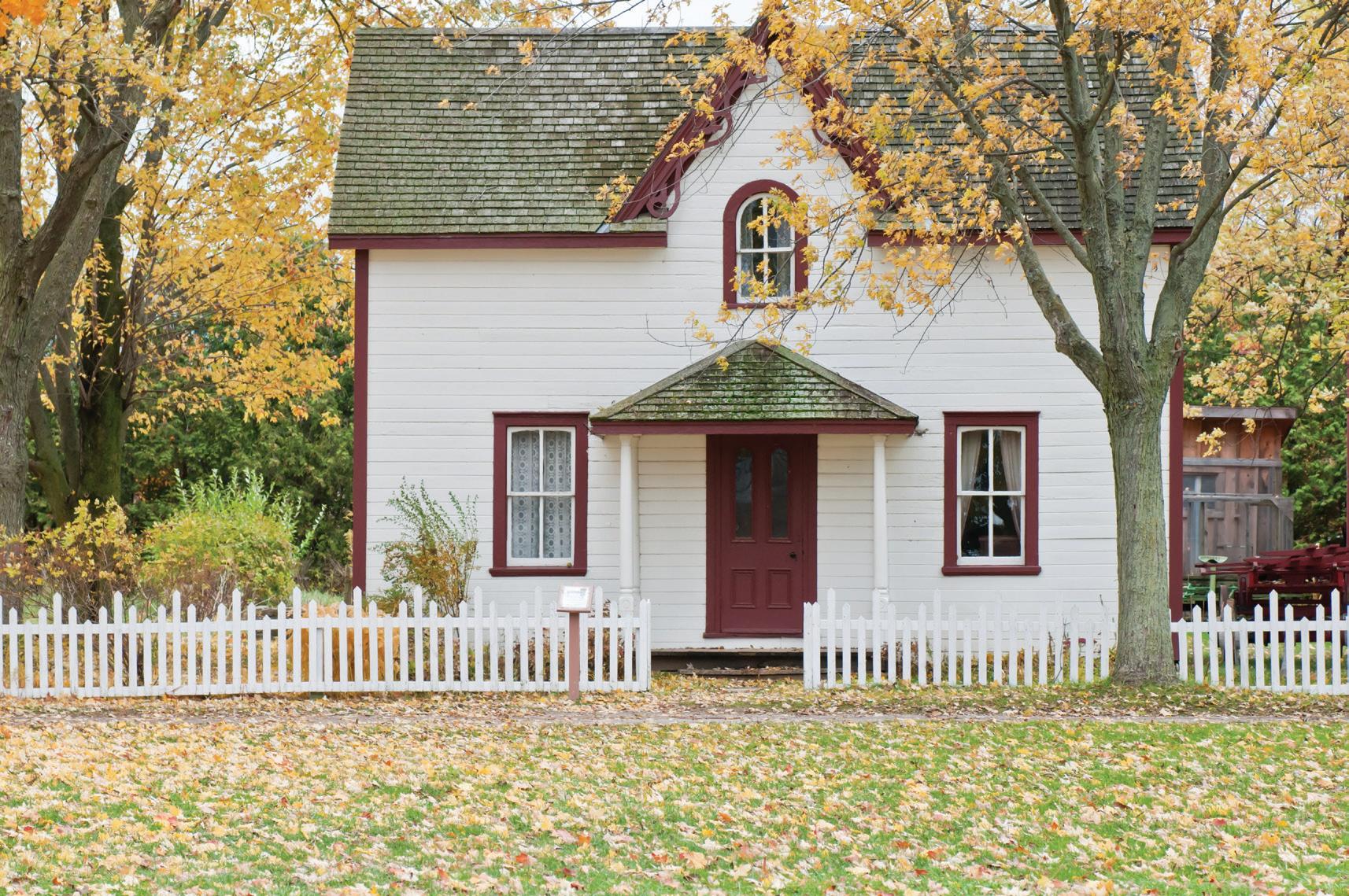

WHERE GAMECOCKS FIND THEIR ROOST
UofSC students post for free when using their UofSC email address.






Columbia’s Magnificent Apartment Community
Life is better under the Oaks! Beautiful 21 Oaks offers cutting edge amenities, meticulously groomed grounds, spacious floor plans designed with you in mind, and a dedicated staff that contributes to a higher standard of living. Only steps away from Williams-Brice Stadium, it’s the perfect location for Saturday’s in South Carolina. Live to tailgate, live 21 Oaks.






3 Bed, 3 Bath 4 Bed, 2 Bath & Super 2 4 Bed, 4 Bath
sq feet 3 Bedrooms, 3 Baths
sq feet 4 Bedrooms, 4 Baths
sq. feet 4 Bedrooms, 2 Baths
Bedrooms, 1 Bath (Split 4x2) Community Amenities Swimming Pool Business and Study Center Clubhouse Pilates and Yoga Room Basketball Court Carports Picnic Areas Fitness Facility Shuttle Service Dog Park Interior Features (*Select Units) Black Appliances Ceiling Fans Washer and Dryer Fully Furnished Balcony / Patios* www.hpi21oaks.com Instagram: @21 Oaks
1,107
1,372
1,108
2

South Carolina football leans on mentorship, transfer portal after making significant changes to running back room
Emma Edwards | Off-Season Sports Beat Writer
South Carolina football will rely on experienced mentors and an updated coaching staff to lead the team’s revamped running back room ahead of the 2024 season.
Head coach Shane Beamer has not shied away from using the transfer portal to add depth and leadership to the team’s roster in the past, and he’s continued to do so in the offseason.
South Carolina finished the 2023 campaign with an injured junior Juju McDowell and an otherwise inexperienced running back room before losing redshirt senior Mario Anderson to the transfer portal and sixth-year Dakereon Joyner to the NFL Draft. In the aftermath of these events, Beamer said he knew the running back room needed more experience, as it consisted of mostly freshmen.
“There’s so many unexpected things,” Beamer said. “A guy goes to the NFL before you think he is, or a guy decides to transfer that maybe you weren’t planning on transferring, and now you’ve got to — I don’t want to say scramble — but you’ve got to readjust. And you realize that it’s not going to be from an in-high-school recruiting, (but rather) you’re going to have to look to the portal for that.”
The name that headlined South Carolina’s new transfer portal class was incoming senior running back Raheim “Rocket” Sanders. The Arkansas transfer was a highly sought-after prospect after emerging as one of the nation’s premier running backs.
“What a weapon he is — big, talented, physical guy,” Beamer said. “As an SEC head coach and as a fan of college football, you knew who Rocket Sanders was.”
Sanders’ most notable season with the Razorbacks came in 2022, when he rushed for 1,443 yards and recorded 10 touchdowns on his way to earning First-Team All-SEC honors. He averaged 111 rushing yards per game that season, making him one of 20 players at the NCAA FBS level whose average per-game rushing total surpassed the century mark.
Players and coaches will look to use Sanders’ experience playing in the SEC as a way to mentor his younger teammates, since he is South Carolina’s only incoming running back transfer from within the conference.
Incoming sophomore running back Jawarn Howell also joined the Gamecocks via the transfer portal this offseason. He said Sanders has already stepped into a leadership role despite his short time at South Carolina.
“Even with Rocket not being all the way healthy right now, he’s definitely been a big part in the running back room,” Howell said. “(He is) just encouraging us, and seeing him go to work every day to get back, ready to come back to us and play as quickly as possible, it plays a big role in the rest of team, knowing how he still wants to affect the team and grow as a team and make the team better, so that just pushes everyone else to go 100 times harder.”
Howell joins the team with the least experience of them all, but he is a promising prospect with multiple years of eligibility remaining.
Howell was named an FCS Freshman AllAmerican and MEAC Rookie of the Year in 2023, when he provided 809 yards on 102 carries and scored nine total touchdowns (seven rushing and two receiving) for the Bulldogs.
While Howell is the youngest player in his position, South Carolina’s more experienced running backs have contributed to his growth both as a player and as a person during offseason training, he said.
“With Oscar, Rocket, those guys, Juju — they are all going to teach you something valuable in the game,” Howell said. “You can just take that and run with it, grow with it and excel to the next level. It’s all about how you take it.”
Another player looking to navigate a new conference is incoming graduate student Oscar Adaway III, a transfer from North Texas. Adaway spent five years with the Mean Green, amassing 1,935 yards on 344
carries before deciding to spend his final year of eligibility with the Gamecocks.
Although Adaway has played college football since 2019, he said there is still room for him to grow.
“(I am) just trying to work on my speed, getting that breakaway speed,” Adaway said. “Now we are playing in the SEC, so running 21 miles per hour isn’t enough because you’ve got safeties out there running 22 and some linebackers running 21.”
The Gamecocks’ three transfer portal acquisitions were not the only changes made to the position group this offseason. The team also hired a new running backs coach, Marquel Blackwell, following the departure of former running backs coach Montario Hardesty.
Blackwell spent last season as the running backs coach at Texas A&M. He held a similar role at Ole Miss in 2022 and the University of Houston in 2020-21. Blackwell brings with him a lengthy resume of experience, as he has coached several NFL players during his college football coaching tenure.
Adaway said Blackwell has already established a goal to achieve in his first season at South Carolina — to make the Gamecocks’ running back corps into a top-25 unit in the nation.
“You have to have guys that are explosive, make people miss in small spaces, willing blockers,” Blackwell said. “Ultimately, you want a three-down guy. Hopefully, our room is full of three-down guys.”
South Carolina’s running back transfers will offer experience and playmaking ability, but the group will have to do things the right way to piece together a strong, cohesive unit for the 2024 season, Blackwell said.
“Really, what we want to do is build a strong foundation where we support, take care of each other and make sure we’re getting better every day and doing things the right way,” Blackwell said. “Looking for those guys to be leaders, you know, first of all, being a great leaders of the offense, and hopefully, we can be leaders on the team, which would develop to being a special group.”

SPORTS 21
FILE – Incoming senior running back Raheim “Rocket” Sanders waves to the crowd during a recognition ceremony for new Gamecock football players before the South Carolina men’s basketball game against Missouri at Colonial Life Arena on Jan. 27, 2024. Sanders will spend his remaining year of eligibility with the Gamecocks after transferring from Arkansas, where he rushed for 2,230 yards with 17 touchdowns over three seasons.
photo: Zoe Orechwa

Competing beyond the field: How club sports obtain funding
The South Carolina women’s club soccer team received a bid to nationals in October for the first time in program history.
But with nationals being in Texas, fourth-year hospitality management student Sydney Mcghee was skeptical about whether they were going to be able to make the trip. The team decided to try using allocated funds, as well as alternative methods, to help pay for the trip.
“I was nervous,” Mcghee said. “In the back of my head, I was like, ‘Okay, cool. We won, but how are we going to get there?’”
Funding for club sports is different compared to other clubs on campus, as they rely on the Sport Club Executive Board to receive money. Clubs must pitch to the board how much money they need for the academic year.
Club sports can’t request funds from both the Sport Club Executive Board and Student Government, limiting their options when it comes to funding. The club also has to explain how they plan to use these funds, so the board knows the money is going to good use.
The Sport Club Executive Board is more likely to prioritize requests for things such as equipment and rental fees because reimbursement can often happen directly.
But pitch meetings are not the only factor the board takes into account when allocating funds.
The board follows a point system to determine how much money to give to different clubs, which is then used to place the clubs into tiers based on their number of points. The highest tier is referred to as garnet, followed by black and then grey. There is also a yellow tier for any clubs that are on probation, assistant director of sport programs James Harris said.
The amount of money a club can receive is based on which tier it falls into. The garnet tier can receive anywhere from $800 to $15,000, the black tier $400 to $10,000 and grey $200 to $5,000.

Higher tiers can be granted some of the lower tiers’ unused money to ensure that they have proper funding for the season, Harris said. For example, clubs within the garnet tier are able to receive some of the money from clubs in the black tier, and the same applies down the line. This encourages clubs to earn as many points as possible to receive more funding.
Clubs must earn a certain number of points to qualify for the garnet tier, said Ryan Everding, the co-president of the board and a third-year finance and economics student. But that’s not the only requirement needed to reach the highest rank.
“We’re also looking for clubs to work in the community,” Everding said. “So to
get in the garnet tier, you have to have 120 classification points and four hours of community service per member, so our goal is that we’re giving back to the community.”
There are several ways organizations can earn points, and some of them are required by the board and Campus Recreation.
SPORTS 22 SPORTS | FEATURE
Will Miller | Club sports beat writer
Source: SPort club executive board
These include tasks such as making sure there are a minimum of two club members that are CPR-trained — which is worth 30 points — and confirming that paperwork is completed correctly, whether that be spending requests or waivers for teams — which ranges from 50 to 60 points.
Clubs can be in a position known as the yellow tier, where they don’t receive any money from the board. The tier is for any club that has 69 points or fewer.
If a club completes only the minimum requirements and one community service hour per member, then it would be placed in the grey tier, which falls into the 70 to 89-point range.
“With those required portions, that is our threshold of the yellow tier. As long as you complete all of those, you stay out of the yellow tier,” Harris said.
Club sports have found other ways to raise money that aren’t directly allocated from the board, as well. The women’s club soccer team sells merchandise, hosts percent nights and requires dues from each club member to participate.
such as gas, with the club reimbursing them later on, said Emily Clune, the copresident of the women’s club soccer team and a second-year finance and supply chain student.
“We drive ourselves and then reimburse our drivers for gas, so it’s a lot of carpooling, which is great team bonding, but it’s hard on our dues,” Clune said. “On top of that, staying in hotels is very expensive, especially when our team has 32 girls.”
Travel expenses take longer to process than other expenses, such as rental or equipment fees. Harris said it is preferred that teams do not spend allocated money on travel.
Any time a team uses funds for travel, they are required to complete a travel authorization form. The process can take at least four weeks due to the multiple levels of approval needed, according to the Sport Club Officer Manual. Teams such as men’s club volleyball choose not to use university funds on hotels despite
it sometimes being necessary for out-ofstate competitions.
The women’s club basketball team plays a majority of its games outside of the state, said third-year neuroscience student Gabby Schwartz, who serves as the club’s treasurer. Schwartz said the club had to create a second team due to the amount of girls trying out, which doubled its expenses.
“As the treasurer, I’m in charge of booking all our hotels and arranging all of that travel. For pretty much all of our games and tournaments, we do go out of state,” Schwartz said. “It does get expensive to have three or four hotel rooms for two nights.”
The team also qualified for nationals, which took place in Wisconsin in midApril. The postseason tournament adds more expenses, with registration fees amassing $775. With the need to cover flights, rental cars and hotel rooms, the team used a GoFundMe to help raise the remaining amount.
“This year, with two teams and with the nationals trip, we definitely needed a lot more,” Schwartz said. “The stuff left over couldn’t sustain all of that.”
The women’s club soccer team also turned to GoFundMe to help pay for its trip to nationals at the end of 2023 after it allocated $500 for the season.
Clune, who serves as the club’s president, said the team had to raise more than $8,000 for its trip to Round Rock, Texas, which included expenses such as flights and hotels.
The trip cost four times the amount the club needed to get to regionals in Henrico, Virginia, earlier that year, Clune said.
The board tries to help by taking unused money from other sport clubs and redistributing it to ones that still need funding for postseason competitions, Harris said.
Clune said she believes there is not enough funding to support club sports on campus. She wishes the university would do a better job of promoting club sports and supplying the teams with

SPORTS 23
Infographics: Callie Hribar
$3,000
internship or co-op
$3,000 end-of-term evaluation … allowed me to see manager & teammates viewed me in a professional setting the opportunity for me guage how accurately knew myself my own work style.
The University of South Carolina is offering supplements for qualified students who work internships and co-ops in Summer 2024 that support high-demand industries in the State of South Carolina. The deadline to apply is June 14, 2024!


for your S.C. end-of-term

Need help with your next steps? Career Coaches are still here to support you! Make an appointment at sc.joinhandshake.com/login

Computing
Student Resources Hub
OR VISIT ONE OF OUR FOUR LOCATIONS University Career Center (Thomas Cooper Library, Level 5) College of Engineering &
(Swearingen, 1A03) Graduate
(Close-Hipp, 204) Pre-Professional & Graduate School Advising (Sumwalt, 208) CONNECT WITH US ONLINE sc.edu/career facebook.com/UofSCcareers instagram.com/uofsccareers 803.777.7280
truly
how
SCAN HERE or visit bit.ly/USCGradPlans
TELL US WHAT YOU’RE DOING NEXT!
out the
and
with us!
evaluation
allowed me to see
my manager & teammates viewed in a professional setting
USC GRADS —
Fill
graduation survey
share
Analysis: South Carolina men’s basketball season ends with heartbreaking first-round loss to Oregon
Brendan Dougherty | Sports Writer
The South Carolina men’s basketball team lost to Oregon 87-73 in the first round of the NCAA men’s basketball tournament on March 21. The Gamecocks’ season ended with a record of 26-8 and a 13-5 record in SEC conference play.
“It hurts to lose, and it hurts more when it’s the last game of the year,” head coach Lamont Paris said. “It hurts the most when you’re surrounded by a group of guys that is a really special group of individuals.”
The Gamecocks never saw much control over the lead in the game, as Oregon entered halftime leading 34-29.
South Carolina led 20-14 with a little over eight minutes left in the first half, but the Ducks went on a blistering 20-9 run to end the half. The first half was seemingly capped on a positive note when fifthyear guard Ta’Lon Cooper banked in a beyond half-court shot at the buzzer to end the half.
The miraculous shot seemed to give a bit of buzz for South Carolina heading into the break, but the Gamecocks failed to capitalize on the momentum to begin the second half. Oregon went on another run in the first six minutes of
the half, leading 55-37 with a little under 14 minutes remaining. The game was plagued by Oregon’s ability to stifle the Gamecocks’ offense.
Another difference between South Carolina and Oregon was the defensive intensity late in the game. The Ducks forced eight steals and six blocks on the Gamecocks, while South Carolina only forced three steals and three blocks.
The Ducks also put the Gamecocks in deep foul trouble late in the game, as graduate student forward B.J. Mack fouled out, and sophomore guard Zachary Davis
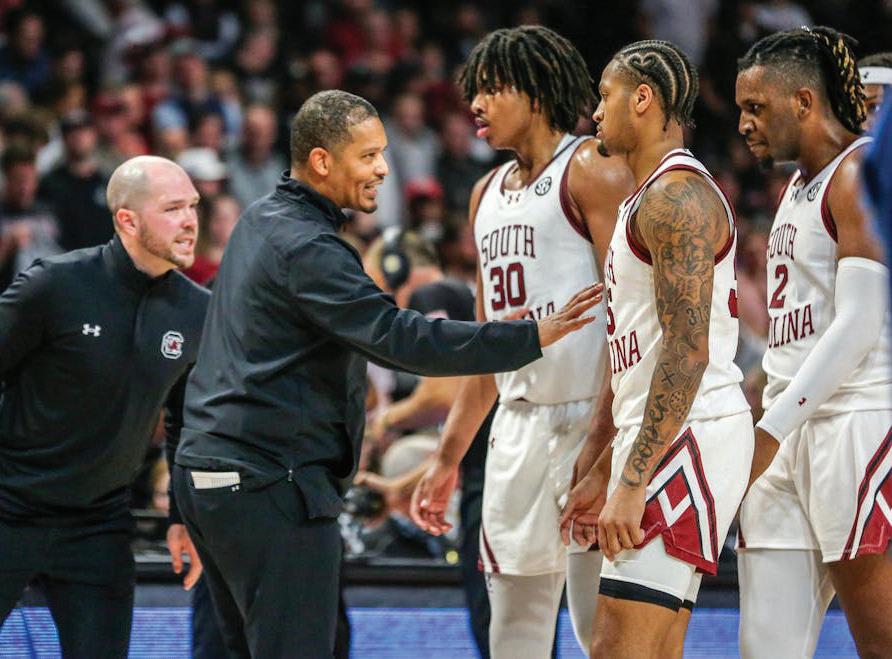
and junior guard Meechie Johnson each finished with four fouls.
South Carolina didn’t get consistent offensive production out of any players besides Johnson, who hit bucket after bucket late in the game in an attempt to close the lead. Johnson finished with 24 points on 9-16 shooting from the field, including four 3-pointers.
The story on the side of the Oregon Ducks came from a familiar face to the Gamecocks in fifth-year guard Jermaine Couisnard. Couisnard, who transferred out of South Carolina to Oregon following the 2021-22 season, finished with 40 points on 14-22 shooting, knocking down five 3-pointers and rising to the occasion against his former team.
Despite falling short in the NCAA Tournament, Paris praised his team for the unexpected success the players produced this season. The Gamecocks were originally picked to finish last in the SEC in the media poll to begin the season but ultimately finished fifth entering the SEC Tournament.
“It’s such a high-quality group of human beings. It would be hard for me to overstate that,” Paris said. “That really is what made this group able to do what they did on the basketball court.”
Paris said the season laid the groundwork for the future.
Freshman forward Collin MurrayBoyles emerged as a budding star, joining the SEC All-Freshman team. The backcourt tandem of Cooper and Johnson saw success, and each of them earned second-team All-SEC nods. Paris won SEC Coach of the Year and was a finalist for the Naismith College Coach of the Year. His success also earned him a sixyear contract extension.
“I really like what our foundation looks like,” Paris said. “I think, more importantly than what those individuals are as basketball players, the culture that we have developed, the way in which we work, the way in which we interact, the way in which we respond to coaching ... that stuff could not be in a better place.”
SPORTS 25
File — Head coach Lamont Paris speaks to players during a timeout in the second half of South Carolina’s game against LSU on Feb. 17, 2024, at Colonial Life Arena. The Gamecocks fell to the Oregon Ducks in the first round of the NCAA Tournament on March 21, 2024.
photo: Taylor Kitchens
Students return to fountain for 3rd women’s basketball title celebration: ‘It’s a once in a lifetime college memory’
The buzzer sounded, signifying the end of the 2024 NCAA Women’s Basketball Championship game, and the Thomas Cooper Library fountain became a sea of garnet and black.
The April 7 victory marked the Gamecocks’ third national title — and the third celebration in the fountain for University of South Carolina students.
The gathering at the fountain also marked the end of the Gamecocks’ revenge tour against Iowa. Last year, the then-undefeated Gamecocks fell to Caitlin Clark and the Hawkeyes and were knocked out of the 2023 Final Four.
Students now revel in memories of the championship from two years ago, when the Gamecocks defeated the University of Connecticut for its second national title.
“It brings back memories from two years ago,” fourth-year economics and mathematics student Weston Watts said in a blue Speedo. “I don’t like Iowa. Caitlin Clark’s great, but I think we’ve proved today that we’re just better.”
Students ran from their watch parties, apartments and Five Points, often blocking Columbia traffic, to join the aquatic celebration.
“Buzzer ended, rushed straight over (from) 650,” first-year real estate student Ryder Ruppe said.
Students splashed in the fountain and felt united in celebrating the Gamecocks’ heavily anticipated victory.
“When everyone was like, ‘We won’ — everyone just came rushing in,” secondyear public health student Sravya Sunkara
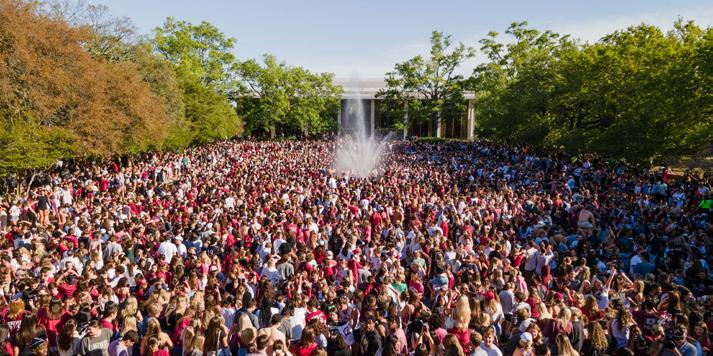
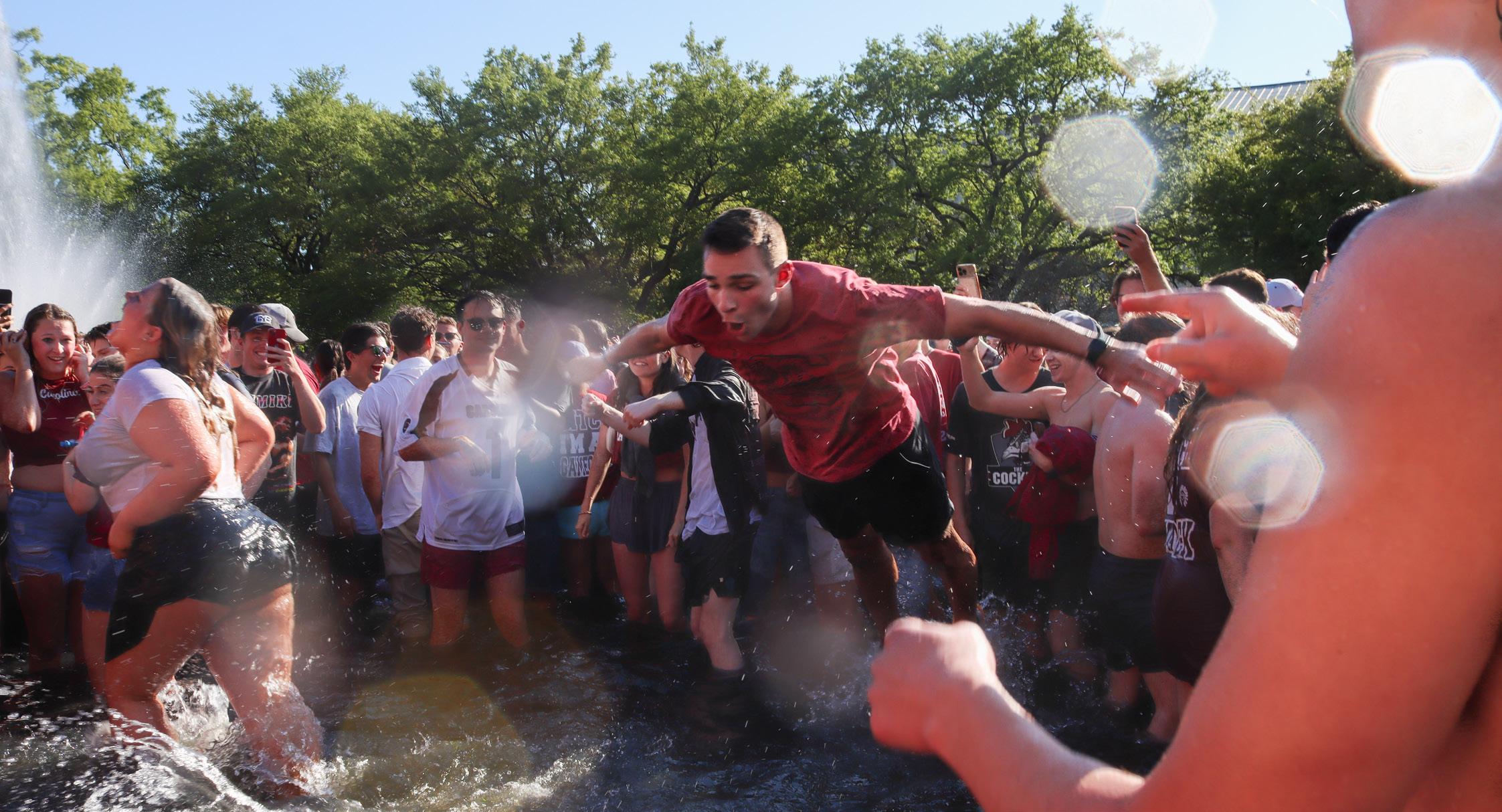
said. “That is just the coolest feeling ever, being part of that team spirit, feeling you’re with a team.”
The festivities brought in all sorts of attendees from the community, both twolegged and four-legged.
“He likes getting in the fountain a lot,” fourth-year Natasia Caldwell said about BMO, her 180-pound water dog. “It’s his favorite pastime.”
Many students said they had been planning their fountain trip all season, some having transferred from other schools to join The Cockpit.
“I finally got my chance,” third-year finance student William Cook said. “It feels good. It’s very worth it to transfer.”
First-years and second-years also got to join in the tradition for the first time.
“The bar’s up high (after my) first year. I’m expecting three more, so they better deliver,” Madison Hall, a first-year political science student, said.
Students said the sprinklers in the fountain added to the experience. Some said the light of the late afternoon created a rainbow in the fountain over the cheering students.
“Going in the sprinkler was the best part because we were just dancing in basically the rain, and I’m so happy we won,” second-year science student Heather Dominus said.
The water in the reflecting pool that USC students see every day was barely visible among the sea of garnet and black, but its fountain served as a beacon.
“I sat right on top of the fountain,” said Sam Wilkins, a third-year exchange student from England. “It was like a bidet from Hell.”
Students said they were both nervous and excited while watching the final seconds of the game.
Holly O’Keefe, a fourth-year international business management
student, said she went to every single women’s basketball game this year. She said the championship game was “unbelievable.”
“I knew that 3-pointers were going to be an issue going in. We’re not great at defending them. But the way that Tessa Johnson (and) Raven Johnson were able to lock her down. Unbelievable game,” O’Keefe said. “Camilla — defense and offense — lights out. I’m just blown away.”
Students looked to the future and made plans to jump in the fountain in future years.
“Jump next year, then the year after that and then the year after that,” second-year early childhood education student Lana Blue said. “Our kids are going to jump in after that.”
emmy ribero | news editor marley bassett | assistant news editor win hammond | assistant news editor colin elam | news writer
Editor’s Note: Hayden Davis, Olivia HelfenandCarriganWoodsoncontributed to the reporting.
A student at the University of South Carolina belly flops into the Thomas Cooper Reflecting Pool after the women’s basketball National Championship win on April 7, 2024. The Gamecocks had a comeback win after suffering from an 11-point Iowa Hawkeyes lead.
South Carolina students swarm the Thomas Cooper Fountain at the University of South Carolina within minutes of the Gamecocks’ 8775 win against the Iowa Hawkeyes on April 7, 2024. The victory marks the Gamecocks’ third NCAA championship win.
PHOTO: delany kral
PHOTO: jatin patel
Analysis: South Carolina women’s basketball claims 3rd national title, 1st undefeated season in program history
GRIFFIN GOODWYN | sports editor
The No. 1 South Carolina women’s basketball team clinched its thirdever national title on April 7 in an 8775 victory over No. 1 seed Iowa at Rocket Mortgage FieldHouse.
Three hallmarks of South Carolina’s game — defense, dominance on the glass and depth — led it to success throughout the season and helped the team to earn the win and complete the program’s undefeated season.
“It’s been a long journey. We’ve trusted each other so much over the season. We have so much confidence with each other, so much love … throughout this whole program, throughout this whole team,” senior guard Te-Hina Paopao said. “To cap it off with a perfect season is just a blessing.”
The opening three minutes of the game were vastly different for both teams. While Iowa’s offense was surging, South Carolina’s was struggling. The
Hawkeyes jumped out to an early 10-0 lead by the two-and-a-half minute mark, and the Gamecocks started 0-6 from the field before senior center Kamilla Cardoso made a layup to break the team’s scoring drought.
The shooting disparity between the two teams continued as the quarter went along, as Iowa was 6-9 on field goals (compared to South Carolina’s 4-14 mark) leading into the game’s first media timeout.
The timeout came at a good time for the Gamecocks, though. South Carolina went on a 7-0 scoring run after the break and cut the Hawkeyes’ lead to 7 points by the end of the period. Senior guard Caitlin Clark played a pivotal role in helping Iowa build on its early lead, finishing the quarter with 18 points on 5-8 shooting and breaking the NCAA Tournament’s all-time scoring record in the process. Clarks’ impact on the rest of the game was diminished by the Gamecocks’ stout

defense, specifically that of sophomore guard Raven Johnson.
Clark scored only 12 points after the first quarter and was held to just 3 points on 1-6 shooting in the second. Head coach Dawn Staley said Johnson’s performance was “psychologically helpful” after last year’s elimination from the Final Four at the hands of Iowa.
“As a player, you want to release certain things that have held you captive. And I do think the waving off in the Final Four last year held her captive,” Staley said. “Raven’s got the bullhorn saying, ‘This is a revenge tour’ … and then for her to actually lock in and play Caitlin the way we needed her to play her … I think it’s pretty cool that she was able to check off a goal and move forward.”
The Hawkeyes as a whole were limited to just 19 points in the second quarter, while South Carolina’s rebounding ability on both sides of the court allowed it to generate scoring opportunities. By halftime, the Gamecocks out-rebounded the Hawkeyes 38-24 and had 10 more made field goals and field goal attempts than the Hawkeyes.
South Carolina finished the game with a 51-29 advantage in rebounds and a 48-32 advantage in points scored in the paint. Cardoso contributed an additional 17 rebounds, along with 15 points, on her way to being named the Final Four Most Outstanding Player.
Cardoso said her teammates’ court vision was pivotal in helping the Gamecocks establish a strong presence in the paint.
“I think just trying to get the post-ups and my teammates finding me and giving me the ball, even though I didn’t shoot really good tonight,” Cardoso said. “We just move the ball really good, and they were able to find me while I was open.”
Those extra scoring opportunities helped the Gamecocks score 29 points in the second quarter. Cardoso and freshman guard Tessa Johnson led those offensive efforts with 7 points each, and Paopao contributed an additional 6.
Tessa Johnson’s scoring contributions carried over to the third quarter, where she nailed two 3-point shots. She finished
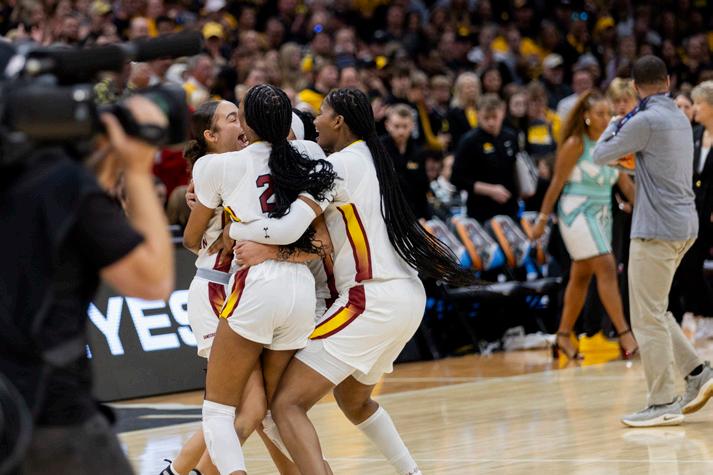
the game with a team-high 19 points off the bench and was named to the AllTournament Team alongside Cardoso.
“She’s trusted her process here. She’s trusted her journey, and for her to do that on such a big stage, I’m so proud of her,” Paopao said. “Her confidence has grown so much, and I’m just really excited for her future.”
Tessa Johnson was not South Carolina’s lone contributor off the bench, as she, sophomore forward Ashlyn Watkins, freshman guard MiLaysia Fulwiley and junior forward Sania Feagin combined to score 37 bench points. Iowa, on the other hand, scored 0.
Paopao said the Gamecocks’ bench players have been a “difference maker” throughout the season.
“We’ve depended on them so much … and they’ve done so much for this team,” Paopao said. “A lot of people sleep on them, but they can start on any team in this country. But they decided to sacrifice that and play for this team and win a national championship, which we did today.”
After describing South Carolina’s NCAA Tournament run as a “revenge tour,” Raven Johnson said the program’s success will continue in the years to come.
“We have the best coach, what — in the country, in the nation, in the whole wide world? There’s no telling what she’s going to add to the pieces that’s already here,” Raven Johnson said. “Be on the lookout.”
Gamecock women’s basketball head coach Dawn Staley holds up the net at Rocket Mortgage FieldHouse on April 7, 2024, after making the last cut in celebration of winning the NCAA National Championship. This is Staley’s third time coaching a team to the national championship.
Freshman guard Tessa Johnson, junior guard Bree Hall, senior center Sakima Walker and senior guard Te-Hina Paopao hug in celebration after winning the national championship game. The Gamecocks completed a perfect, undefeated season ending in a national title for the first time in program history.
PHOTOs: ALICIA CARACCIOLO
Carolina Competitive Dance Club looks to offer lane for dancers of all levels to explore passion
Lea Khalil, a third-year neuroscience student, started dancing at the age of 2.
By fifth grade, she began competing in competitions up until she graduated high school. And after coming to South Carolina in 2021, Khalil decided she wanted to continue her dance journey.
Now Khalil, who is minoring in dance, has started a new club dance team to help students compete and perform at the collegiate dance level regardless of their experience or background in dance.
Carolina Competitive Dance Club performs in showcases every semester and competes in dance competitions around Columbia. The 2023-24 academic year is the club’s first year on campus.
The club performs a wide variety of dance styles, each with its own practice schedule. Khalil said members are not required to attend a minimum amount of classes — just as many as they would like.
But the club wasn’t the easiest to establish, Khalil said. The Sport Programs Office wanted her to combine with other dance clubs on campus.
“Originally, when I tried to make the club they told me, ‘No, it’s too similar to stuff we already have. Try to merge with this club instead,’” Khalil said.
She then met with the president of Swype, another dance club on campus, to discuss the potential merger, but Swype ended up deactivating. Khalil’s club did not look like it would get approved during her sophomore year. But by the end of spring 2023, Khalil decided to try again.
“I just kind of gave up for my sophomore year and focused on my studies. At the end of my sophomore year, I was like, ‘I really need to keep trying for this because it’s something that I’m passionate about, and it means so much to me,’” Khalil said. “And so I tried again, and it worked.”
Khalil started to try finding potential students to fill executive positions, such as Sam Golding, a second-year public health student, who is the fundraising and campus relations chair.
Golding said she heard about the new organization by word of mouth. And when

she came on board, she started planning how the club could best recruit students during the fall semester.
“Over the summer, we worked to spread the word, get ourselves certified through the university, all of that. We held interest meetings, we went to the student org fair, we tabled and we just kind of — that was our way of getting out there,” Golding said. “Right now, currently, we’re using social media, and we’re trying to increase our social media presence as well as just reaching out.”
They also set up tables at organization fairs and handed out flyers with links to its social media pages, helping gain interest in the club.
But once the club gained more members, Khalil and Golding were faced with another task: How were they going to pay competition fees and rent to practice at Strom Thurmond Wellness and Fitness Center?
Carissa Reebel, a second-year finance and statistics student and the treasurer of the club, created detailed budget sheets laying out member fees for the semester to help the organization keep track of its finances.
The club also started holding percent nights, a fundraising night where a percentage of the money raised goes back
to the organization. Golding said she hopes to expand more into other ventures, such as apparel and other merchandise.
The team has raised money all on its own to help pay for competitions, Khalil said.
Club members have the option of being on the performance team, meaning they would be in the showcases it puts on. The team has its first fall showcase in December and then another in March.
Dancers can also choose to participate in the dance competitions, but they are required to audition. But, any member of the organization is allowed to compete in the solo, duet and trio events without needing to do an audition.
The club has 18 people in competition groups and 10 to 15 people on the performance team.
“I’m the kind of person — I’m not going to turn any dancer away,” Khalil said. “There is an audition process for joining the competition team.”
Club member Taylor DiFondi, a first-year biology student, does a mixture of both performance and competition. She has enjoyed her experience and made new bonds through the club, she said.
“I love all the girls and, honestly, just every practice is so fun. It definitely helps that our teachers or instructors are close to us in age,” DiFondi said. “So we respect them as teachers, but we also get to bond with them and become friends with them, so it’s just a really fun dynamic throughout the club.”
Khalil said she hopes to continue to expand and stay true to the idea of creating a place for anyone passionate about dance, regardless of background. The club creates a space for students who don’t have the ability to afford other dance outlets, she said.
“In dance, you have those girls who — they have the money and resources where they can practice every single day of the week, and you can really see those results. And then you also have people who aren’t given that same opportunity,” Khalil said. “I wanted to give the opportunity to compete to those individuals ... I really wanted to focus on the people who are often, I guess, looked over in the dance world.”
28 WIll miller | CLUB SPORTS BEAT WRITER
The Carolina Competitive Dance Club poses for a group picture on Dec. 5, 2023, in the Russell House Ballroom. The 2023-24 academic year is the club’s first year on campus.
PHOTO Courtesy of Sam Golding
This month in Gamecock sports history
Will Kelly| ASSISTANT SPORTS EDITOR
April has been a month of glory for the Gamecocks. While many sports take it easy and enjoy the offseason, a select few of South Carolina’s teams have geared up for the final stretch of their seasons, looked toward postseason tournaments and even outright won a national championship (or three). Here’s a list of notable things that have happened in the month of April for Gamecock sports.
2010 The baseball team went 13-3, boosting it to the program’s first-ever College World Series, which was the university’s first national championship in a men’s sport, and boasted a 54-16 record.
2011 The baseball team went 15-3 before winning its second College World Series with a 55-14 record. The Gamecocks have not been to the College World Series Championship since and have yet to replicate this record.
2013 The softball team won its first game in the Carolina Softball Stadium in a 5-0 shoutout over Appalachian State on April 3. The Gamecocks went 34-25 (8-16 SEC). It lost to Tennessee in the SEC Tournament Quarterfinals and was eliminated in the NCAA Regionals.
2017 The men’s basketball team suffered a 77-73 defeat to Gonzaga on April 1 in the university’s only men’s basketball Final Four appearance. The Gamecocks finished the season 27-11 (12-6 SEC) under then-head coach Frank Martin.
2017 The women’s basketball team won its first national championship on April 2, defeating the Mississippi State Bulldogs 6755. The victory marked the university’s third overall national championship title in seven years. The Gamecocks went 34-4 (14-2 SEC) en route to its quest for national glory.
2022 The women’s basketball team won its second national championship under head coach Dawn Staley on April 3, defeating the UConn Huskies 64-49. The Gamecocks had a 36-2 (15-1 SEC) record, with its only losses coming from Missouri and Kentucky.
2024 Gamecock women’s basketball won its third national championship in seven years, defeating the Iowa Hawkeyes 87-75. The Gamecocks went undefeated for the first time in program history, a feat that has only been accomplished nine times previously. Six of those times, it was done by UConn.


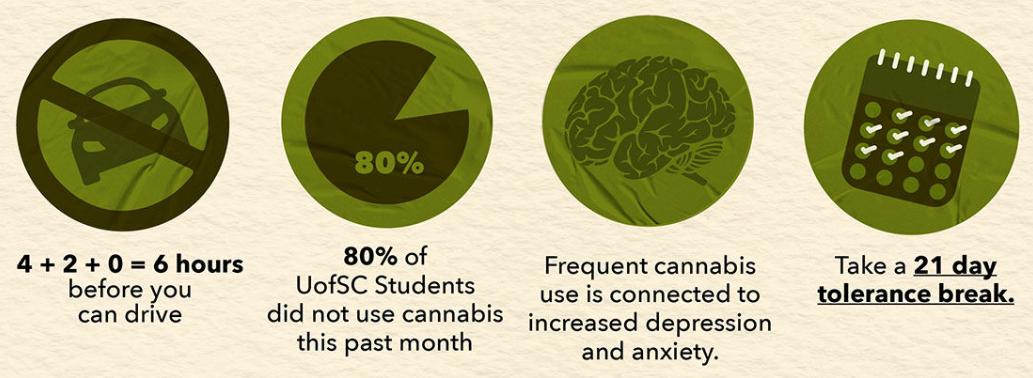
Do you have questions about cannabis ?

29
South Carolina baseball defies preseason expectations, struggles to find its rhythm early on in 2024 season
As the Gamecocks neared the end of March, the team’s preseason expectations for its hitting and pitching flipped.
Head coach Mark Kingston said during his preseason availability in January that he believed the team’s strong suit heading into the 2024 campaign was its seasoned batting lineup.
The Gamecocks returned multiple starters from last season’s offense, which hit 117 home runs overall. The starters include two Preseason All-Americans in sophomore outfielder Ethan Petry and junior catcher Cole Messina.
“I think our hitting is pretty well established,” Kingston said. “When you have two All-Americans returning, when you have a 19-home-run guy returning and you have a lot of other really good hitters back — they’re a year stronger, a year better. I think it’s pretty safe to say our offense is going to be really good.”
More uncertainty surrounded the Gamecocks’ pitching staff, as it had lost five pitchers to the 2023 MLB Draft. Messina said he was optimistic that the pitching staff would contribute to the team’s success this season despite the losses.
“I see a group of guys that work extremely hard every day who can really help us,” Messina said. “I think that a lot of people will be shocked come opening day, and I think they’re going to prove a lot of people wrong.”
Across South Carolina’s first 23 games, though, the performances of both its batting lineup and pitching staff contradicted preseason expectations. The Gamecocks’ offense struggled to score runners, while its pitchers served as the backbone of the team’s early-season success.
As of March 25, the team has struck out 221 times — the second-highest total in the SEC behind Missouri at the time. South Carolina was also ranked 11th in the conference in hits with 211.
Several players contributed to the Gamecocks’ early offensive slump, including senior first baseman Gavin Casas, who had has trouble reaching base since announcing his return to the program last July. Casas has a .216 batting average and has only hit two home runs while striking out 12 times.
Messina has encountered some earlyseason roadblocks, as well, earning just nine hits in 42 at-bats across his first 11 games. He also went hitless in the
team’s first SEC series of the season against Ole Miss.
South Carolina’s offensive struggles reached a tipping point following two consecutive losses to Clemson in early March. After the series, the team’s hitters had a meeting with the coaching staff to get to the bottom of their inconsistency, Kingston said.
“It’s a work in progress for us. There’s no question about that. We’re not going to hide from it,” Kingston said. “We get on base a lot. Now we just need to make that next step and get over that hump of getting those guys in pretty consistently.”
South Carolina’s offense has shown some improvement, though, amassing 40 runs over its midweek content against USC Upstate from March 19 and weekend series against Vanderbilt from March 23 to 24.
South Carolina’s pitching staff, however, started the season with an impressive string of performances. The Gamecocks allowed just 5 runs in its opening series against Miami-Ohio, striking out 27 batters throughout the three-game set.
As of March 25, The pitching staff as a whole boasted a 2.96 ERA and allowed only 83 runs — the third-fewest in the SEC at the time.

“I think our pitching staff is way better than everybody says it is,” Petry said. “They have made significant improvements since the fall, and it’s showing how (pitching coach Matt Williams) is working with them.”
The Gamecocks’ rotation is led by junior pitcher Eli Jones, who has emerged as a starter. Jones earned a 2-0 record and 2.45 ERA through his seven games started this season, tallying 28 strikeouts and allowing 10 runs over 36.2 innings pitched.
South Carolina has also seen contributions from less experienced members of its pitching staff, such as freshman pitcher Eddie Copper. Copper, who has earned a starting role since the start of the season, accumulated 27 strikeouts and a 4.56 ERA over 23.2 innings pitched.
Jones and Copper have headlined the Gamecocks’ pitching prowess as members of the starting rotation, but the bullpen has also become a source of strength for the team.
Junior pitcher Chris Veach has been called out to help the team when runners are on base, becoming a reliable safeguard late in games. Across 17.2 innings of work, Veach has allowed just 8 runs on 14 hits and has totaled 24 strikeouts.
Senior pitcher Garrett Gainey, who transferred from Liberty University during the offseason, has also provided the Gamecocks with energy during his lateinning appearances. Gainey has struck out 27 batters throughout 17.0 innings pitched and has only given up 6 runs and 13 hits all season, earning him a 3.18 ERA.
Kingston said Williams, who was hired as the Gamecocks’ pitching coach in June 2023, has played a pivotal role in helping the team’s pitchers reach their true potential.
“We knew we had that talent. I think what Matt Williams has done a great job with is just really helping these guys harness what they can do and attacking the strike zone,” Kingston said. “I’m just very pleased that what we thought we would be getting out of these guys, we are getting. And with a lot of them, we’re getting even more.”
30
Senior left-handed pitcher Garrett Gainey celebrates after striking out a batter during South Carolina’s game against Clemson at Segra Park on March 2, 2024. Gainey recorded six strikeouts in the Gamecocks’ 5-4 loss to the Tigers.
Hardy
Smothers | SPORTS
WRITER
PHOTO: Taylor Kitchens







24/7 Gym & Clubhouse In unit Washer & Dryer Package Lockers Large Patios & Balconies Resort Style Pool 24/7 Study Rooms CONTACT US TODAY: (803) 779-5888 | RIVERSEDGECS.COM | @RIVERSEDGE CS Apply Today! Now Leasing For 2024-2025
New assistant football coaches look to elevate player mentality, improve running game ahead of 2024 season
Dylan Bailey | SPORTS WRITER
South Carolina head football coach Shane Beamer has been amid a coaching carousel after an underwhelming 2023 season.
The Gamecock football team has made five coaching changes to its staff in the offseason, bringing in many new and old faces to the program. But Beamer ultimately still has his eyes set on achieving his goal of winning a championship at South Carolina.
“When I was hired in December 2020, that was my goal — is to bring a championship to Columbia, South Carolina,” Beamer said. “And absolutely nothing has changed, and I want to do that for our players, I want to do that for our coaches, I want to do that for our amazing fans — the greatest fans in America — because there’s no reason why we can’t.”
Two hires from the offseason include wide receivers coach Mike Furrey and tight ends coach Shawn Elliott. Elliott formerly served as the Gamecocks’ run game coordinator.
Furrey and Elliott are looking to instill a winning mentality into the team from two offensive positions that contributed to the Gamecocks’ going 5-7 in the 2023 season.
South Carolina hired Furrey on Feb. 29 after James Coley, whom Beamer had hired to be the team’s wide receivers coach earlier in the offseason, departed the program. Coley left to become Georgia’s wide receivers coach just over a month after he was hired.
But Coley’s departure may have come to South Carolina’s benefit, Beamer said, as he believes Furrey was the better candidate for the position.
“(I) didn’t think we’d be here again introducing a wide receivers coach, but it is what it is. The previous receivers coach made a decision that he felt was best for his family,” Beamer said. “And then it allowed us to go out and hire an even better wide receivers coach in mind, and that’s not a knock on anybody, but that’s what I feel about (Furrey).”
Furrey served as head coach at Limestone, a Division II program in Gaffney, South Carolina, for two seasons. There he led the team to back-to-back 8-4 seasons and became Limestones’ all-time winningest coach (20-25). This was
Furrey’s second stint at Limestone, as he previously worked for the program in 2016 and 2017.
Furrey said his experience as a head coach will make an even better assistant coach.
“You just kind of have an idea of what you want your assistants to do, right? Take some burden off you, do your job, keep your office clean, look good, be presentable, get your players ready, get them to study,” Furrey said.
Furrey brings several years of prolevel experience to South Carolina’s wide receivers room.
He played in the NFL for seven seasons, where he made appearances on both sides of the ball. In 2006, Furrey led the NFC in receptions with 98 while playing for the Detroit Lions. A season prior to his breakout as receiver, Furrey played as a safety for the St. Louis Rams.
He said his focus is to find a method that will help improve South Carolina’s wide receivers and help them maximize their potential, mainly through making sure every player is putting in the most out of every snap, whether that be during walkthroughs, practice or game days.
“I think when you go out there, and you watch us run around, it’s not going to be shy of effort,” Furrey said. “It’s not going to be shy of exhausting ourselves for a better purpose, and that’s our team. And we’ll practice like that, we’ll play like that, we’ll run routes like that. There will always be a purpose, but it’s going to be at a maximum effort that’s going to be behind that.”
Elliott, another major coaching hire this past offseason, is far from a stranger to the Gamecock football program.
Elliott served on the team’s coaching staff for seven seasons from 2010 and 2016 and played an instrumental role in some of South Carolina’s most successful seasons.
Elliott was originally brought on as an offensive line coach and running game coordinator in 2010 and became cooffensive coordinator in 2012 — a position he held through the rest of his tenure — with a brief stint as interim head coach in 2015 when Steve Spurrier resigned midseason. He was a part of the Gamecocks’ best offensive season, where it averaged
34.1 points and 452.3 yards of offense per game in 2013.
“When I was looking at this position, it was something (like), ‘How can we be better? Who makes us better?’ And there’s no question that Shawn Elliott makes us better,” Beamer said in Elliott’s introductory press conference.
Elliott became head coach at Georgia State following his tenure with the Gamecocks. He built Georgia State’s program on the success of the running game, and his teams have averaged 214 rushing yards per game over the past five seasons.
Elliott earned Georgia State’s first winning season as a recognized Football Bowl Subdivision team as well as notable victories over Tennessee in 2019 and No. 21 Coastal Carolina in 2021. He also accumulated four bowl victories in five trips with Georgia State.
His decision to rejoin South Carolina boiled down to home and family, Elliot said.
“When this position became available, I targeted it,” Elliott said. “I reached out and wanted them to know that this was something that I wanted to do. For many reasons, but ultimately, I think for my family. The most important people in my life live here in the state of South Carolina.”
Elliott and Beamer said they are hoping to lead South Carolina to the top of the SEC, win
championships and elevate the program to another level of success.
“I’m looking forward to making an impact here on the University of South Carolina,” Elliott said. “Their players, their coaches, everyone involved. I know I have the passion, and I’m here to inspire, motivate and do everything I can to put this program right where it needs to be, and that’s at the top of the SEC and the country.”
Elliott hopes to improve a South Carolina run game that finished the 2023 season with just over 1,000 rushing yards. Former running back Mario Anderson, who had 707 yards in the 2023 season, led the unit, but he transferred in the offseason. One of Anderson’s replacements is junior running back Raheim “Rocket” Sanders, who transferred from Arkansas.
Furrey and Elliott rounded out a busy offseason of coaching hires for South Carolina. Despite all the offseason turnover that transpired, Beamer said the team has already improved from where it was at the end of the 2023 season.
“(I) couldn’t be more excited about the staff that we’ve put together,” Beamer said. “And there’s no question that since the end of the season, we’re better, as a team and as a program.”
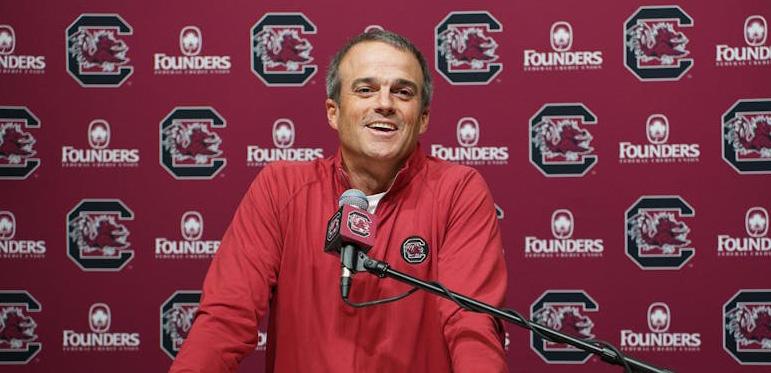
32
File — Head coach Shane Beamer speaks to members of the media at the Long Family Football Operations Center on Nov. 14, 2023. Beamer recently hired wide receivers coach Mike Furrey and run game coordinator and tight ends coach Shawn Elliott to the Gamecocks’ football staff.
PHOTO: Myles Harris








New USC concert venue to spotlight local artists, students
Jake Albright | ARTS & CULTURE WRITER
Local music artists now have the chance to perform in an intimate space at Live at the Underground, USC’s newest music venue.
Hosted by the Music Industry Studies program in the Russell House basement, the Live at the Underground team aims to provide a unique listening experience for students and be a platform for local artists, said Katheryn Ailes, one of Live at the Underground’s marketing directors.
“We really want to have something that caters to everybody’s interests,” Ailes said. “(We want to) give (artists) a place where they can come and practice performing at
a very low-pressure environment in front of their peers.”
Student artists will have the opportunity to perform on Wednesdays from 7 to 10 p.m. at the venue.
At Unplugged Cover Nights on the first Wednesday of each month, artists will be able to perform 10-minute sets. Applications are open on Live at the Underground’s Instagram page.
One artist who took advantage of Live at the Underground’s opening performance is first-year music industry studies student Jeremiah Hardison, who goes by the stage name MATTEUS!.
Hardison said the venue was the best environment he had ever performed in due to its atmosphere and acoustics.
He said the venue’s location in Russell House is a plus, as it helped him present his unreleased tracks to an audience of his peers.
“It’s your chance to expose yourself to as many people as possible,” Hardison said. “That’s where everybody is.”
First-year music industry studies student Luis Melendez, who goes by the stage name LUCK!, also performed at the first show. Melendez praised the venue setup.

“(My performance) was a lot more up close, and it felt more real,” Melendez said. “I think it’ll give us a platform and an audience. It’ll help us build a fanbase.”
Ailes said she was pleasantly surprised by the turnout of the first show, and she has her sights set on maintaining the venue’s early success.
“We were over the moon about (it). But obviously, a successful first show doesn’t mean an overall success,” Ailes said. “This is something that (sponsors) Gamecock Entertainment and Carolina Productions and Russell House really want to be a longterm thing.”
To maintain student engagement, the team plans to introduce theme-specific nights. Ailes said country and heavy metal could be on the list of upcoming themes.
The Live at the Underground team also has plans to integrate new visual elements in the venue to express these monthly themes, Ailes said.
“We have a lot of plans for it, as far as what we want it to look like and how we want to decorate it,” Ailes said. “So it is as visually appealing as it is, hopefully, to the ear.”
To involve more local bands, the team has deemed the second Wednesday of every month a “Hometown Throwdown,” where bands that are local, but not necessarily USC affiliated, can perform.
Ailes said she hopes to involve students who perform well at open mic nights as openers for larger bands.
The Live at the Underground team also plans to host regional touring acts on the last Wednesday of every month. Ailes said she hopes to secure acts that students might be unable to afford to see at other venues.
“(Concert tickets) aren’t getting any cheaper,” Ailes said. “It’s really difficult for (students) to get access.”
These acts include artists such as the Broken Speakers and Opus and the Frequencies, who have already performed at the venue.
Students can attend the events as long as they bring their CarolinaCard.
Photo: TAYLOR kITCHENS
The doors to Russell Underground, a multipurpose venue for students, show a logo on April 5, 2024. The Music Industry Studies program started Live at the Underground to create a platform for local artists to perform on Wednesday nights.
Local farmers use Soda City to connect to Columbia community, educate on healthy produce practices
Gabi roder | ARTS & CULTURE WRITER
Stanley Gruber, the owner of Gruber Farms in St. George, South Carolina, sets up his stand at 9 a.m. on Saturdays during the spring, summer and fall months for the Soda City Market in Columbia.
There, he lines his table with a colorful assortment of produce before locals fill north Main Street.
For some local farmers, their produce businesses give them the opportunity to share their heritage and love for the community. With events such as the Healthy Carolina Farmers Market at USC and Soda City, Columbia has given
farmers a new way to connect with their customers.
Mandy Churchwell, the owner of The Veggie Patch, a farm in Neeses, South Carolina, said her farm is more than just running a business.
Participating in the USC market allows her to provide students with affordable, healthy produce in place of the unhealthy options that college can encourage.
“This market was for the students and faculty to have a chance for healthy fruits and vegetables instead of kids grabbing fast food all the time,” Churchwell said.

The Veggie Patch has always maintained strong family values, Churchwell said. Farming has been Churchwell’s main form of business for years, even though it started as a food resource for the family. But she knew it could be something more, she said.
“My family has always been in farming. My grandparents, parents before them, so it’s in our blood,” Churchwell said. “(It) started off just providing for our family. You would work and have a garden to supplement your food. And then about 16 years ago, I said, ‘Dad, let’s make this into a business.’”
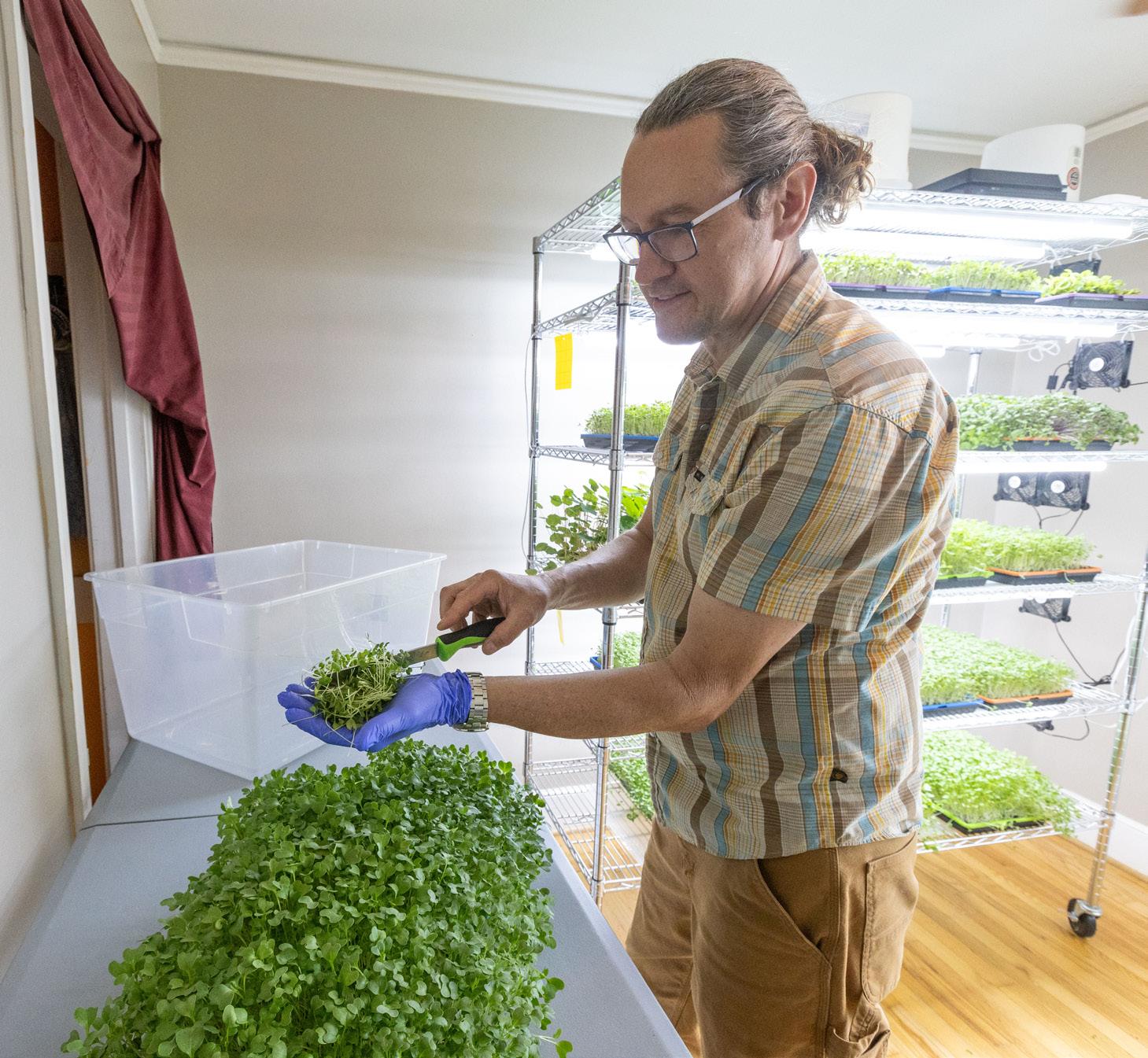
Selling at the Healthy Carolina Farmers Market has allowed her to build close relationships with students at USC and members of the USC community, Churchwell said. Now, she is returning to the market for her 16th year.
“I have met children here — students — that I’ve known them for many years, from freshman all the way to sophomores, seniors and graduates,” Churchwell said. “Every year, you get some that come back every week, and they love the market. And you build a little relationship with them.”
Customers of the Healthy Carolina Farmers Market have their own produce preferences, Churchwell said, so she maintains a variety of fruits and vegetables to meet the community’s different needs.
“You kind of have to balance. You have to have fruits and vegetables because most students, they like fruits or something they can grab and take to class,” Churchwell said. “But now, people like faculty, they want to take stuff to their houses and cook for the week. They’re more toward the vegetable side.”
Gruber also has experience running a family farm. After his father died, Gruber retired from his job and took over the business, which was started in 1948.
Gruber grows more than 40 different crops, spanning from strawberries and watermelons to squashes and cucumbers. His farm sells seasonally at Soda City Market, which has given him the opportunity to connect with the community, he said.
The work is worth it for the loyal customers and connections that he’s made along the way, he said.
“I just wanted to get something to put me closer to the people that are actually eating the produce that I grow,” Gruber said.
Some farms such as Gruber’s originally started as wholesale, meaning he sold his produce to buyers, grocery stores and
photos: tara o’toole
Left photo — Microgreens are pictured on March 29, 2024, using urban farming methods. Microgreens are grown within 11 days at Daly Greens Farm.
Right photo — Keith Hearns harvests a Rainbow mix, which includes blue kale, red cabbage, purple radish and amaranth on March 29, 2024, at Daly Green farm.
other retailers. But Gruber said selling at the market and delivering to Community Supported Agriculture drop sites is the best way to bring him face-to-face with his customers.
Keith Hearn, the owner and operator of Daly Greens farm, also has a stand at Soda City. Daly Greens is a small farm grown in his house, and it sells produce such as micro greens, hydroponic lettuce and mushrooms.
Hearn’s produce is grown using a method called hydroponics, which is the practice of growing plants with a water-based solution instead of soil. The micro greens have 40 times the nutrition than the mature plant and are rich in an assortment of A, C and B vitamins, Hearn said. Similar to Churchwell, Hearn said his stand allows him to provide the community with access to healthy food options.
“Making sure that there was healthy foods out there available for people, especially during the pandemic — that was when I really launched into making sure that people had really good, healthy, nutrient-dense food,” Hearn said.
Hearn grows and harvests his produce inside of his home. He has a setup of around 30 different trays for his microgreens, which are partnered with supplemental lighting above the plants to support their growth. The plants are then harvested with a simple cutting tool.
Daly Greens produce is different from other stands at Soda City, but it gives Hearn the opportunity to educate people on the craft, he said. If anyone approaches him with questions, he makes an effort to keep customers coming back to his stand.
“Every time a person does walk up, I give them the same gracious knowledge about everything and try to make sure that they are now a customer,” Hearn said.
Farming comes with its own set of difficulties, though. Hearn and Gruber said bringing produce to the table can be both pricey and tedious at times.
Gruber Farms is one of many farms across the country that belongs to Community Supported Agriculture, a system that connects local farms with restaurants, buyers and families within the community. The system works in conjunction with the farmers market and helps maintain the farms’ cash flow by acting as an additional service outside of the wholesale and markets, Gruber said.
Community Supported Agriculture is a subscription-based service. People in the community can sign up online, choose their haul size and get produce delivered to them once a week, Gruber said. It allows people to buy products made available by farmers.
“(The service) gives me operating money ahead of time because all of this stuff is expensive to grow, very expensive — and getting worse,” Gruber said.
Gruber Farms used to mainly plant row crops, which are crops such as cotton or corn that can be planted in rows. The business has since shifted to working
with produce that aligns more with Community Supported Agriculture, such as fruit or vegetables that would be used in local restaurants or sold at the markets. Gruber said it is pricey to maintain, but even small-scale farms such as Daly Greens have crops that require delicate maintenance.
Hearn said the practice of microgreen upkeep is very tedious and thus leaves room for error.
“It takes about 10 or 11 days to get the microgreens done. The mushrooms take about a couple of months,” Hearn said. “It’s a process, and you can mess up at any

point because there are so many spores floating around in the air everywhere, that if they get into your bags then they get ruined.”
When customers go to the markets, they give farmers such as Gruber, Hearn and Churchwell the opportunity to see the impact of their hard work. They are also supporting a local business, helping the Columbia community thrive, Gruber said.
“We’ve met a lot of good people over the years,” Gruber said. “And I’ve got a lot of loyal customers that come to me every year.”
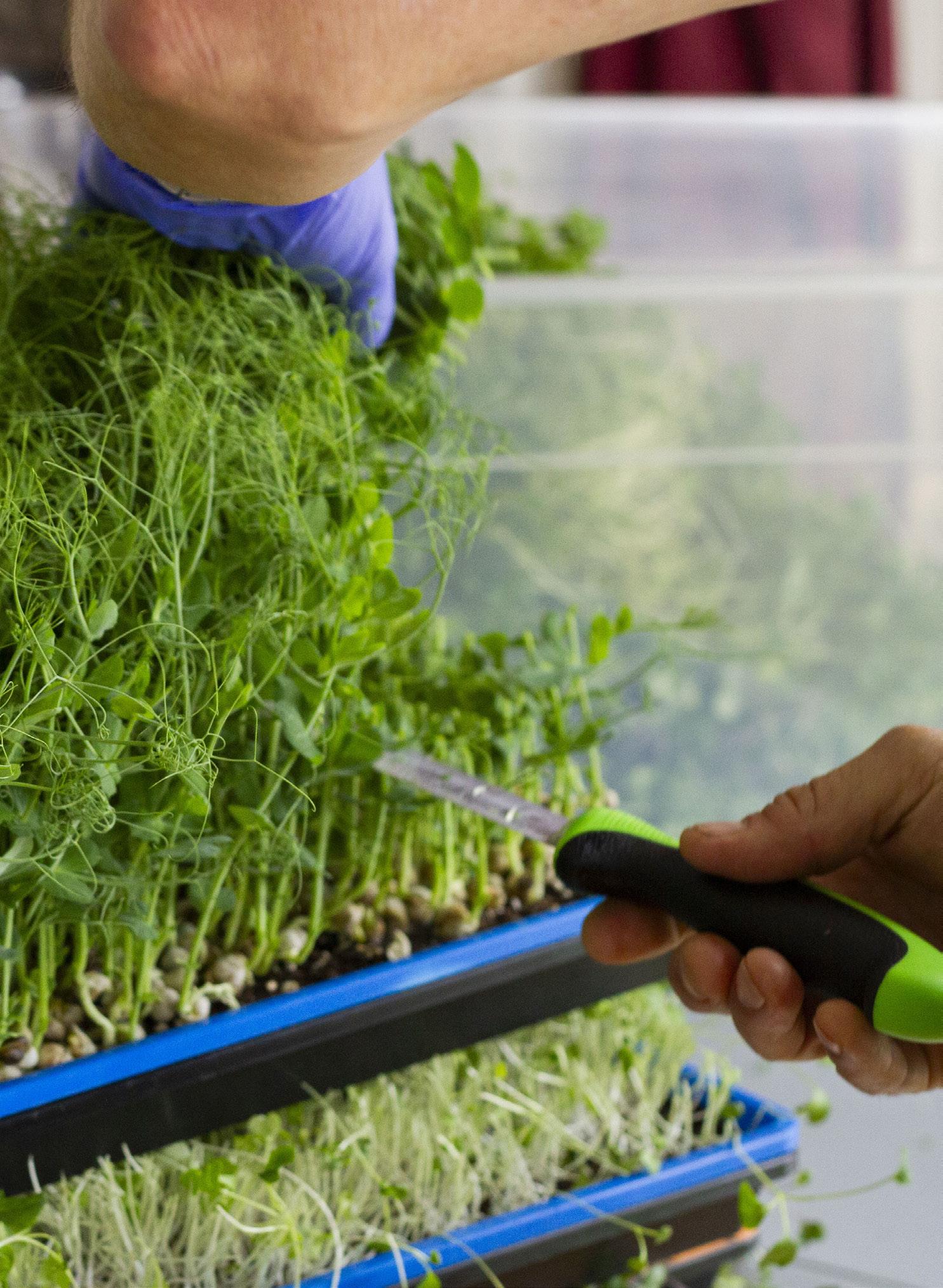 Left — Keith Hearns harvests a Rainbow mix, which includes blue kale, red cabbage, purple raddish and amaranth on March 29, 2024, at Daly Green farm.
Right — Pictured on March 29, 2024, is a prepared rainbow mix container including blue kale, red cabbage, purple radish and amaranth. Daly Greens brings these microgreens to Soda City every Saturday.
Left — Keith Hearns harvests a Rainbow mix, which includes blue kale, red cabbage, purple raddish and amaranth on March 29, 2024, at Daly Green farm.
Right — Pictured on March 29, 2024, is a prepared rainbow mix container including blue kale, red cabbage, purple radish and amaranth. Daly Greens brings these microgreens to Soda City every Saturday.

Column: A Russell House expansion would be good for USC
KENNA HUGHES | OPINION WRITER
For many USC students, Russell House is a popular place to convene, eat, study and get work done. Whether they’re picking up a bagel from Einstein Bros. after class, attending a meeting in one of the ballrooms or swiping a CarolinaCard for access to the dining hall, this student union is at the forefront of students’ college experience.
But many have spent more than an hour waiting for their Einstein Bros. order to be ready, have gotten lost trying to find the room they are supposed to meet in or have been trampled by what feels like the entire university trying to eat dinner at the same time.
Now with the proposal, the student union could become much bigger. This would give students the chance to do everything they have done before — just with more breathing room. The architectural blueprints boast a vast, open space with lots of seating, grand staircases and skylights that the sun is able to shine through.
Although many details about the estimated $240 million project have yet to be shared with students, first-year international business and finance student Kaleigh Erler has ideas about what the new student union should include to make for a quicker, easier student experience. Erler, a member of USC’s Freshman Council, advocates adding more restaurants for students with allergies, more study spaces and more meeting spots for clubs and student organizations. Because Russell House is such a central part of students’ college experience, it needs to be able to accommodate them all, she said.
“It’s the hub of all of campus,” Erler said. “That’s probably the one place you’ll see all four years come together.”
Expanding Russell House and making its components more efficient could accomplish Erler’s vision, allowing the student union to play a more integral role in the everyday lives of USC students.
USC is known to have the best public first-year student experience in the country, but Erler said Student Government wants to extend that to other years as well.

Additionally, having a more openconcept student union would allow students to sit and eat comfortably instead of struggling to find an open table.
“Expanding (Russell House), making it more open, more of a food court, like in a mall — It’s kind of like what my friends have at Alabama. It’s very nice,” Erler said.
By increasing the size of the building and adding more seating areas, less people would have to crowd around the restaurants in giant masses, which would create a less stressful environment for students and workers alike.
The health center behind Russell House, known as the Thomson Building,
“While we do focus a lot on our freshmen, I think we also need to take into account there’s the upper levels too that need just as much support, if not more,” Erler said. “Providing them with those resources too and making them feel like they’re a part of the community still, even if they’re off campus ... (is) an important point.”
would also become a dining hall, which would make the area as a whole feel more cohesive. Although the building offers many beneficial resources, such as quiet meditation rooms and counseling services, its hidden location often prevents students from discovering them.
Even though the proposal estimates that the project would not be completed until summer of 2028, that does not mean USC would not accommodate people in the meantime. The Thomson Building could become a dining hall in the proposal in summer of 2026 — two years before the new student union would be finished. This would allow students to eat and socialize with each other even while the rest of Russell House is under construction.
There are many other dining options on campus that students could explore while
they wait for the possible construction to be done. Dining halls such as Gibbes Court, Honeycomb Cafe and Community Table are all places where students can grab a bite to eat, do homework and socialize. Greene Street is also known for its food trucks and farmers markets, where students can get breakfast, lunch or dinner. The potential expansion of Russell House is something for all students to look forward to, regardless of their graduation date. Having a larger, more efficient student union can strengthen bonds between students, increase their productivity and give them a greater sense of belonging on campus. Not to mention, it would also give USC a new and improved look that students will be proud to be a part of.
Photo: julia spies
FILE — Gamecock Park, an all-you-care-to-eat dining hall, is pictured inside Russell House on March 13, 2024. Potential upgrades to Russell House have been proposed to accommodate the growing number of students at the university.

Column: USC needs to improve accessibility on campus
Varsha Gowda| OPINION EDITOR JENNA SWENSon| ASSISTANT OPINION EDITOR
Having adequate, accessible accommodations for students with disabilities is instrumental to fostering an inclusive learning environment. But at USC, this has not been accomplished.
Some academic buildings and dorms are not accessible and need to be updated so they can accommodate students with disabilities. Some of these buildings lack elevators or have closet-sized elevators, some buildings lack ramps and some of the walking paths on campus are not accessible, as they are either too narrow or uneven.
It is important that universities make their facilities accessible so that all students can use their campus, which students paid tuition for, comfortably.
A survey from the National Center for Education Statistics found that 20.5% of undergraduate students reported having a disability defined as a physical, mental and emotional condition for the 2019-20 academic year. While that number may seem small, it is enough for universities to start making strides in upgrading their campuses’ accessibility. Some already have.
New Mobility, a magazine for active wheelchair users, published a report in 2020 called “Wheels on Campus: A Guide to Wheelchair-Friendly Education” that reviews some of the most wheelchairfriendly campuses prospective students should consider.
Among these universities were the University of Arizona, University of Illinois, Auburn University and the University of Florida. Some of their special features included large bathrooms with roll-in showers as well as wheelchair maintenance and repair shops throughout campus.
While amenities such as those are likely costly, these universities are prioritizing the well-being of all of their students, which is arguably worth the money.
USC needs to do a better job emulating other universities that have successfully incorporated inclusive accommodations. Every student, regardless of their ability, deserves to have access to the same opportunities.
Rebecca Hill, the assistant director of the residential certificate
program for students with intellectual and developmental disabilities, CarolinaLIFE, said the university is lacking accommodations for visually-impaired students.
“There’s not braille at every building, there’s not braille on every sign,” Hill said.
Sarai Deese is a third-year neurodevelopment in minorities student and president of Delta Alpha Pi, an honor society that recognizes high-achieving students with disabilities. These students often face obstacles when it comes to campus activities, Deese said.
Deese works in the university’s Institute for Mind and Brain — a building that has no elevator, she said. There are only two staircases separating the top floor, where researchers work, from the bottom floor, where participants for studies are met.
This design makes it especially difficult for physically-impaired people, particularly people who cannot walk on their own to navigate the building. USC should be more proactive in making multi-story buildings more accessible by taking measures such as installing elevators.

“So, there is an assumption that disabled people are not the ones doing research about disabled people,” Deese said.
This assumption is unfair to disabled students, as they should have the equal opportunity to participate in all activities on campus.
It is clear that the lack of elevators and no other options to travel throughout the building other than stairs reflects the university’s unconscious biases towards students with disabilities. If these students were taken into account, the building would accommodate them.
The university needs to work on eliminating any unconscious biases it may have toward the disabled community. Because of these biases, there are pitfalls in making the school accessible for all students, such as design faults regarding safety procedures.
Disabled students shouldn’t have to be in a situation where they are in more danger compared to their able-bodied peers. Ablebodied students have the ability to run quickly out of burning buildings, whereas handicapped students have to wait to be rescued by the fire department while they are in imminent danger. There needs to be better evacuation plans for physically handicapped people in these situations. At the very least, the university should inform students about what they need to do in emergency situations before they move into their dorms.
“Fire evacuations fall on the individual. And when they get to college, it’s not even told to us, but if you are using a mobility aid and you need to be evacuated during fire situations, you have to call the fire department,” Deese said.
This is one of the ways students with disabilities struggle with dorms on campus, but not having guaranteed on-campus housing will create even more problems for them since it will limit their access to campus.
“Pushing upperclassmen off of campus drastically affects disabled people in a way that doesn’t affect other people,”
PHOTO: Mike Ranly
40
A sign reading “Out of Order’’ is taped to the doors of an elevator near East Quad and the Blossom Street Garage on March 29, 2024. The elevator grants students who are unable to use the nearby staircase access to the pedestrian bridge that crosses over Blossom Street and connects to the center of campus.

Deese said. “Yes, there are buses ... Half of them aren’t even accessible.”
Molly Peirano, the associate vice president for Civil Rights and Title IX and ADA Coordinator, said freshmen are the only class that is prioritized in the housing process as they are required to live on campus. After that class is assigned housing, everyone else goes through the lottery system.
The university needs to provide disabled students with first priority in the oncampus housing selection process. Even if they are guaranteed housing for a year, the same room or dorm is not guaranteed each year. The university should make efforts to allow disabled students to keep the same room or dorm for the rest of their college years.
Deese has a service dog, who helps assist her and is trained to find her room. Having students, such as Deese, change their room every year makes it difficult for Deese since she has to retrain her dog every time she moves.
By ensuring that disabled students have on-campus housing, they would be able to get to their
classes and other on-campus activities more easily.
In response to the problems experienced by students with disabilities, the university has started to create some resources and initiatives to make the reporting process easier. The university is creating a website that will allow students to report issues they encounter on campus, as well as ask for accommodations in an easier fashion than the current website allows, Peirano said.
Sonia Badesha, the director of the Student Disability Resource Center, said the university is also working to crack down on professors who prohibit the use of technology in their classes. Even though the Student Disability Resource Center provides academic accommodations for those students, they could feel signaled out or even embarrassed to be the sole student using technology. Badesha said there are alternative measures that professors can take to control the potential distraction technology causes in the classroom. From assigning pop quizzes to having teacher assistants walk around the room, these are both manners in which distractions could be monitored, she said.
Going forward, the school should design its buildings with physically disabled people in mind. They should all include accessible elevators, ramps and properly labeled signs in braille. Buildings such as Wardlaw lacks braille signs and appropriately sized elevators, and Gambrell lacks braille signs as well.
The university could fix these issues by improving existing accommodation services and installing new ones around campus.
One of the innovations USC could install is called a “curb cut,” which is a depression in the sidewalk that connects it to the adjoining road, like a ramp. Curb cuts would also benefit more than just those that use wheelchairs.
“One of the innovations USC could install is called a “curb cut,” which is a depression in the sidewalk, like a ramp, that connects it to the adjoining road.” Hill said.
The university has to start listening to the concerns of its students and faculty in order to improve its accessibility. Who knows better about what the campus needs than its own community?
“Really listening to people with disabilities — students with disabilities — is the best thing that the school can do to ensure that they’re meeting the needs of the students, faculty and staff with disabilities that work and live and participate on campus,” said Mary Alex Kopp, the vice president and chief public relations officer of Able SC.
There are organizations on campus that advocate for better resources, and there have been efforts made to inform the university about the struggles they face, such as the Disability in Action class. The class gave disabled students in the Honors College and CarolinaLIFE a platform to talk and research about the inequities around campus. The students even presented their findings to the university.
With USC’s inaccessible structures, the university needs to be receptive to the issues that concern physically disabled-students and make the changes needed.
USC needs to be aware of its shortcomings and realize that it needs to serve all students, not just its able population. With better planning and researching, the university could make its campus more equitable.
PHOTO: Mike Ranly
41
The control panel sits outside of elevator EV01 in the Solomon Blatt Physical Education Center on March 29, 2024. The elevators, which until recently were labeled as out of order, allow people to access all parts of the building.
Get to know us
WHAT IS YOUR JOURNALISM PET PEEVE? JENNA SWENSON
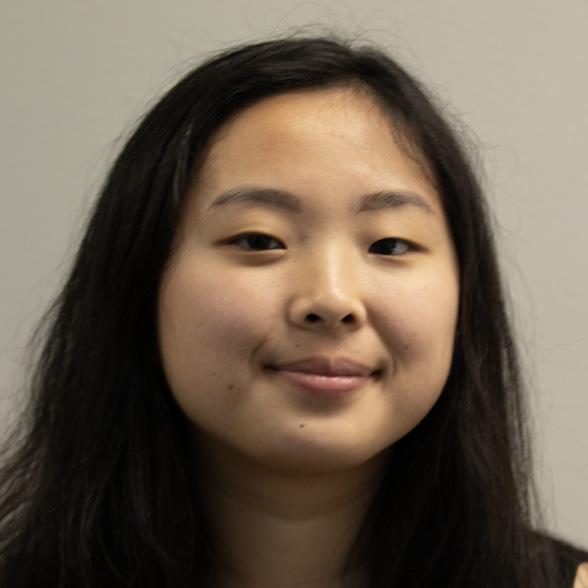
ASSISTANT OPINION EDITOR
My biggest journalism pet peeve is when readers want to beef over X. It’s impossible to please everyone, and nothing good happens on X. Speech is free, but what’s the point of arguing through a post?
ELISE LO
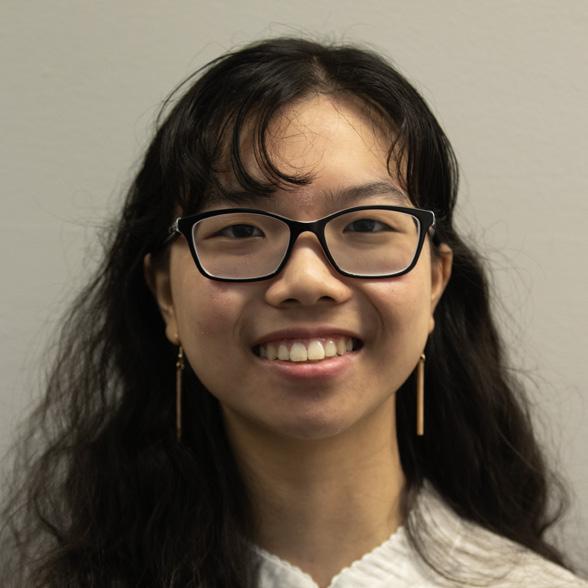
ASSISTANT COPY DESK CHIEF
My journalism pet peeve, as an editor, is when an interview recording is unclear and hard to hear. The thing is, when you’re in person, the person you’re talking to sounds clear, but unfortunately your device ends up picking up a bunch of random noises. It can be really tedious to try to listen back to.

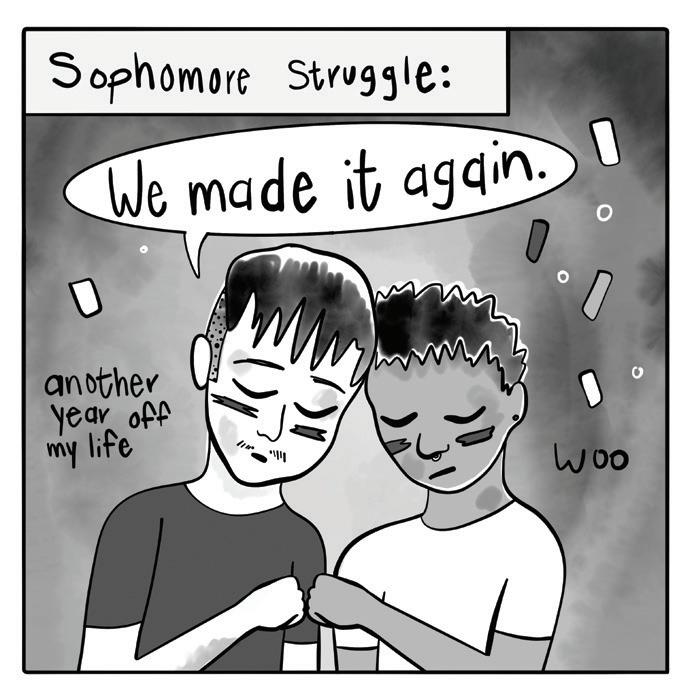


EMMA DAVISSON
INFRASTRUCTURE BEAT WRITER
I’m not a J-School student, so I’m usually bad about following journalism related rules. My biggest pet peeve is definitely when Emmy Ribero, the news editor, takes out my Oxford commas and then gets mad at me for using Oxford commas.





800 Alexander Road | (803) 772-2200 Secure your home at Alight today. Scan to learn more MEMORIES BEGIN WHEN YOU MOVE IN

EDITOR-IN-CHIEF
Kate Robins
MANAGING EDITORS
Riley Edenbeck, Ava Rossini
CREATIVE DIRECTOR
Savannah Nagy
NEWS EDITOR
Emmy Ribero
ASSISTANT NEWS EDITORS
Marley Bassett, Win Hammond
SPORTS EDITOR
Griffin Goodwyn
ASSISSTANT SPORTS EDITORS
Annie Poteat, Will Kelly
ARTS & CULTURE EDITOR
Macaila Bogle
ASSISTANT ARTS & CULTURE EDITOR
Damian Bertrand
OPINION EDITOR
Varsha Gowda
ASSISTANT OPINION EDITOR
Jenna Swenson
BEAT WRITERS
Emma Davisson, Emma Edwards, Jaydon Ford, Will Miller, Carrigan Woodson
CO-DESIGN DIRECTORS
Callie Hribar, Anna Ottinger
SENIOR DESIGNERS
Clay Laucella, Grant Richa
CO-PHOTO EDITORS
Alicia Caracciolo, Taylor Kitchens
SENIOR PHOTOGRAPHERS
Delany Kral, Emma Wyatt
ENGAGEMENT DIRECTOR
Elena Keller
SOCIAL MEDIA DIRECTOR
Awani Bildikar
MULTIMEDIA DIRECTOR
Emma Connelly
COPY DESK CHIEF
Bridget Tracy
ASSISTANT COPY DESK CHIEFS
Elise Lo, Addison Scott
STUDENT MEDIA DIRECTOR
Sarah Scarborough
ASSISTANT DIRECTOR OF STUDENT MEDIA
Sydney Cranmer
ART DIRECTOR
Krista Larson
ADVERTISING DIRECTOR
John Burbage
FACULTY ADVISOR
Brandon Shulleeta
CREATIVE SERVICES
Chloe Ehlers, Lily Ferguson, Jada Mack, Savannah Nagy, David Olsen
AD SALES TEAM
Ariana Herbas, Biffy Skeels, Delaney Flanagan, Kylie Kurinsky, Sofia Sabatino, Marisa Tartamella Sofia Sabatino, Marisa Tartamella
EDITOR sagcked@mailbox.sc.edu
NEWS sagcknews@mailbox.sc.edu
OPINION sagckopinion@mailbox.sc.edu
DESIGN sagckdesign@mailbox.sc.edu
ARTS & CULTURE sagckarts@mailbox.sc.edu
SPORTS sagcksports@mailbox.sc.edu
PHOTO sagckphoto@mailbox.sc.edu
SOCIAL sagcksocial@mailbox.sc.edu
NEWSROOM 777-7726
J O IN O U R TE A M
Want to join The Daily Gamecock?
Check us out at garnetmedia.org/join T
Get our news delievered right to your inbox. Subscribe online at dailygamecock.com/subscribe
The Daily Gamecock is the editorially independent student newspaper at the University of South Carolina. Dailygamecock.com, along with a daily email edition, is your online source for The Daily Gamecock's coverage of all things USC. Check us out on Facebook, Instagram and X, formerly known as Twitter, for news updates around the clock. Opinions expressed in The Daily Gamecock are those of editors or authors and not those of the University of South Carolina. The Board of Student Publications and Communications is the publisher of The Daily Gamecock.
The Office of Student Media is the newspaper’s parent organization.
The Daily Gamecock is supported in part by student activity fees.
dailygamecock com

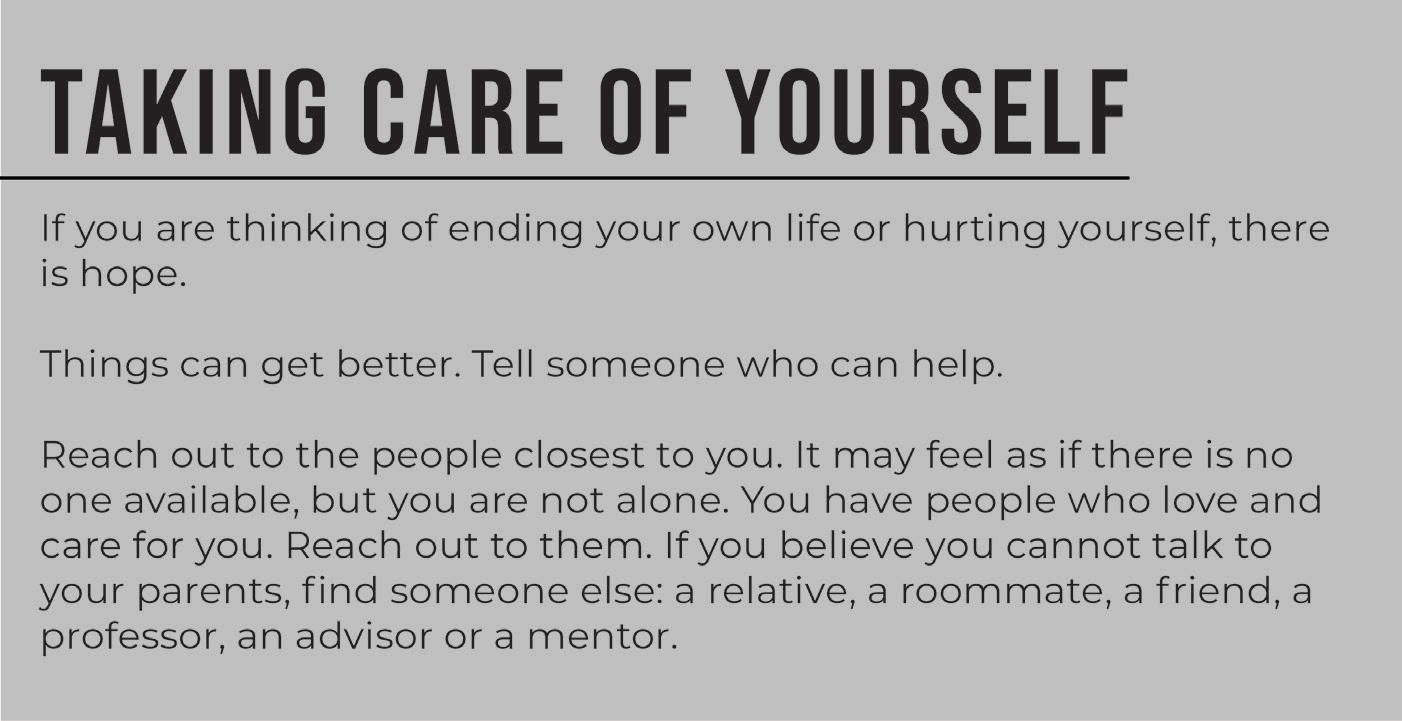


C
TA C T I NF O R M AT
O N
O N
I
Offices located on the third floor of Russell House
D G E M A IL E DI TIO N
The Daily Gamecock @dailygamecock @TDG sports @thegamecock @dailygamecock




Go to dailygamecock.com/subscribe






The Russell House, 1400 Greene Street, Columbia, SC 29208 • 803-777-4160 • /UofSCBookstore /UofSCBookstore /UofSCBookstore SHOP IN STORE OR ONLINE: SHOPGAMECOCKS.COM IN-STORE AND ONLINE SHOP GAMECOCKS GEAR IT’S EASY TO FEEL AT HOME HERE.






























































 Photos of the interior of Vanessa Alaimo’s apartment and the exterior signage of 650 Lincoln show the apartment’s features. 650 Lincoln is home to Honors College students, Living and Learning Community students and student athletes.
PHOTOS: JOSHUA BOUCHER & NICKOLAS HILL
PHOTOS: ALICIA CARACCIOLo & EMMA WYATT
Photos of the interior of Vanessa Alaimo’s apartment and the exterior signage of 650 Lincoln show the apartment’s features. 650 Lincoln is home to Honors College students, Living and Learning Community students and student athletes.
PHOTOS: JOSHUA BOUCHER & NICKOLAS HILL
PHOTOS: ALICIA CARACCIOLo & EMMA WYATT




































































 Left — Keith Hearns harvests a Rainbow mix, which includes blue kale, red cabbage, purple raddish and amaranth on March 29, 2024, at Daly Green farm.
Right — Pictured on March 29, 2024, is a prepared rainbow mix container including blue kale, red cabbage, purple radish and amaranth. Daly Greens brings these microgreens to Soda City every Saturday.
Left — Keith Hearns harvests a Rainbow mix, which includes blue kale, red cabbage, purple raddish and amaranth on March 29, 2024, at Daly Green farm.
Right — Pictured on March 29, 2024, is a prepared rainbow mix container including blue kale, red cabbage, purple radish and amaranth. Daly Greens brings these microgreens to Soda City every Saturday.






























